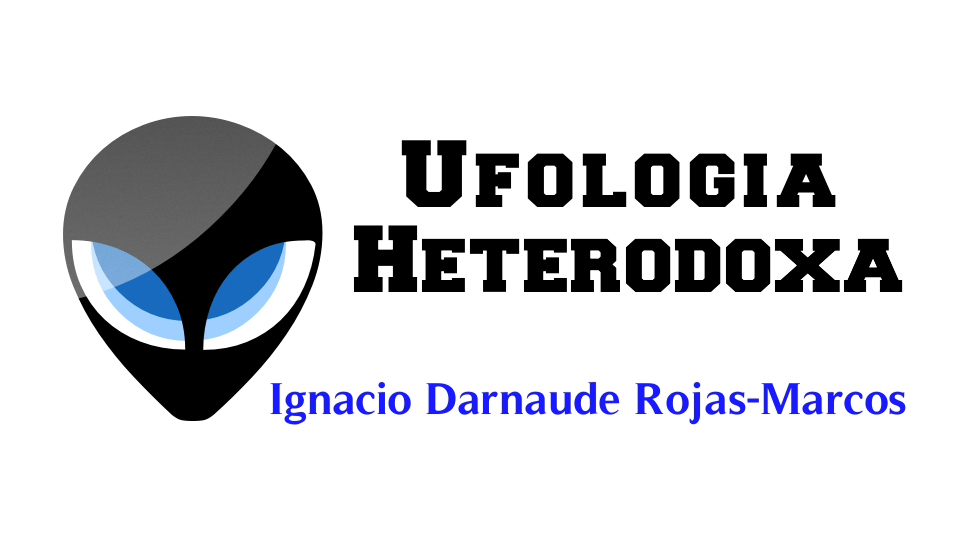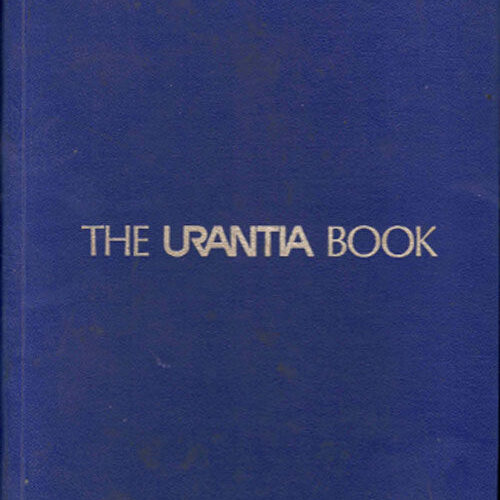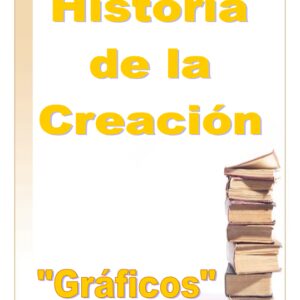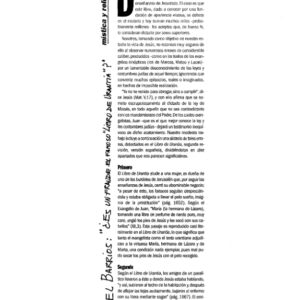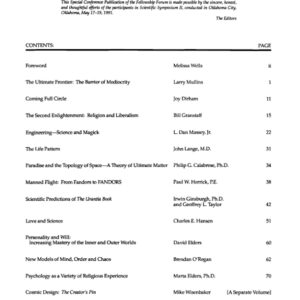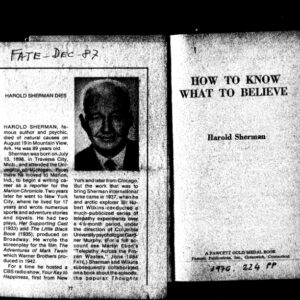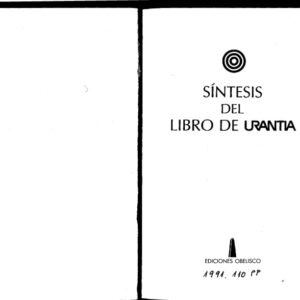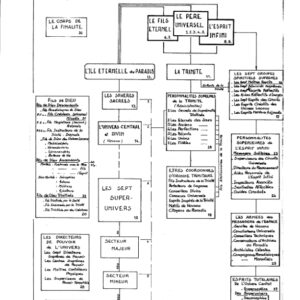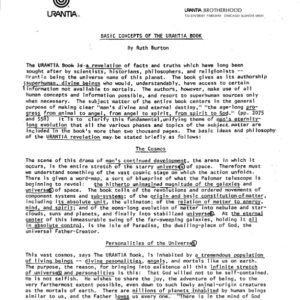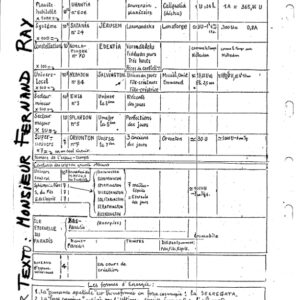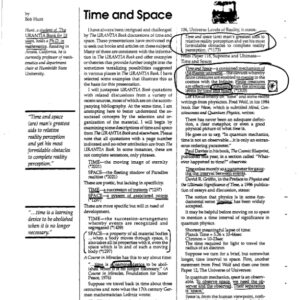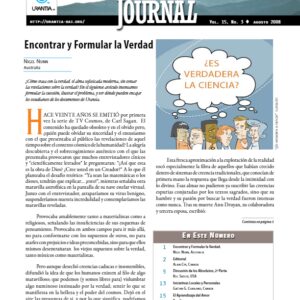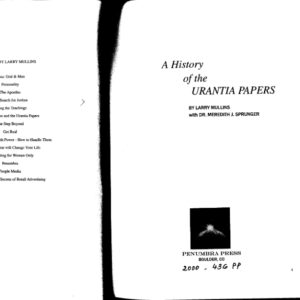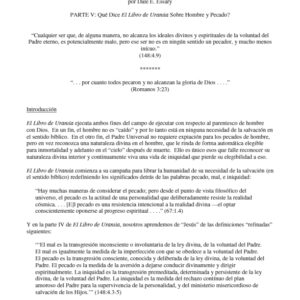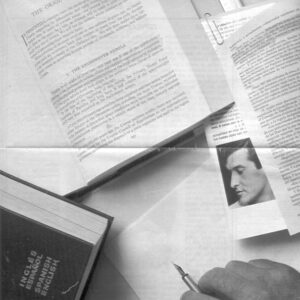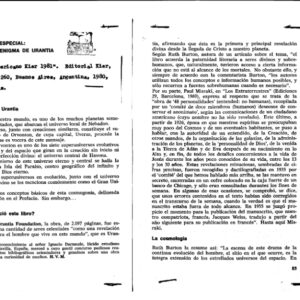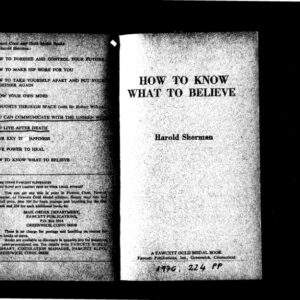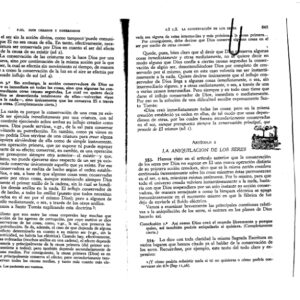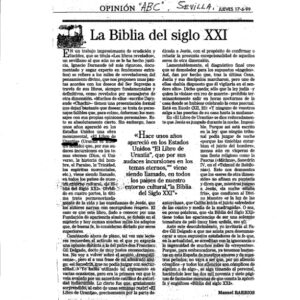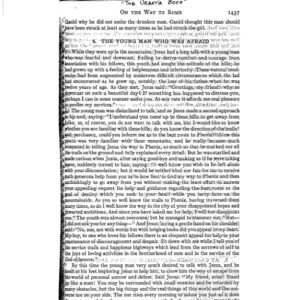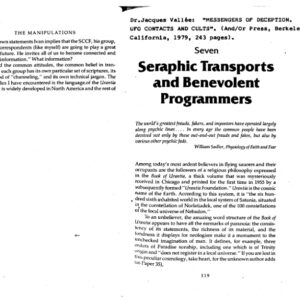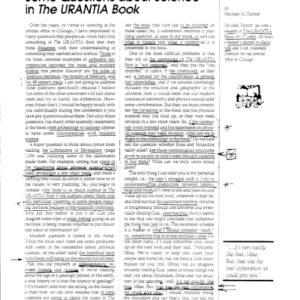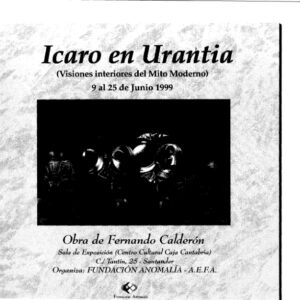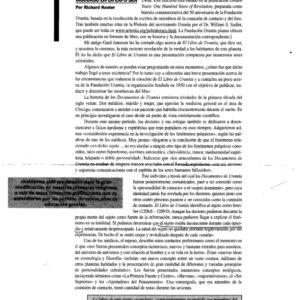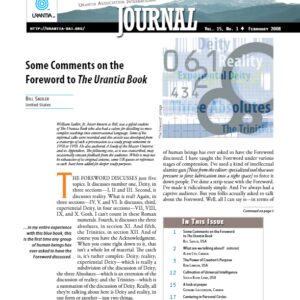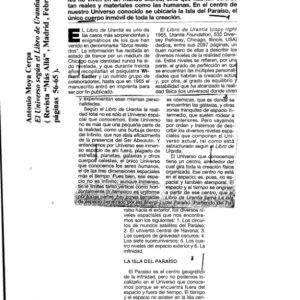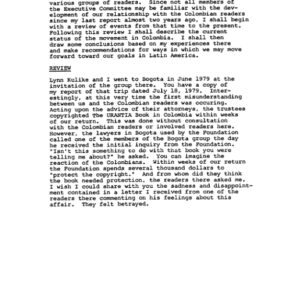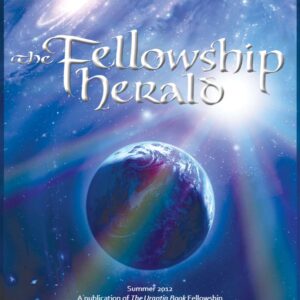The Science Content of The Urantia Book
- Descripción
Descripción
The Science Content of The Urantia Book

Editors: Richard Bain, Ken Glasziou, Matt Neibaur, & Frank Wright
This text has been prepared for use by bona fide students of The Urantia Book, may not be sold, and is restricted to use for study and research purposes only. Quotations from The Urantia Book are indicated in the text.
It is available in booklet form from the editors.
Poised to counteract any reaction of skepticism regarding the revelatory authority of The Urantia Book there is the extraordinarily detailed knowledge of all manner of topics displayed by it, authors at a time when computers and databases were quite unknown, plus the sheer beauty of concept, clarity of presentation, and the depth and scope of its statements in the fields of religion, morals, and ethics. Moreover, there are the many statements of a scientific nature which have since been vindicated by modern scientific research and which, in the absence of prior knowledge, would have been sheer guesswork at the time they were made.
«The existence of God can never be proved by scientific experiment or by the pure reason of logical deduction. God can be realized only in the realms of human experience.»
In the next paragraph we are told:
«Those who know God have experienced the fact of his presence; such God-knowing mortals hold in their personal experience the only positive proof of the existence of the living God which one human being can offer to another.» (1:2.4)
Further emphasizing the role of human experience, on pages 1105-1106 we are told:
«The fact of religion consists wholly in the religious experience of rational and average human beings. And this is the only sense in which religion can ever be regarded as scientific or even psychological. The proof that revelation is revelation is the same fact of human experience; the fact that revelation does synthesize the apparently divergent sciences of nature and the theology of religion into a consistent and logical universe philosophy, thus creating a harmony of mind and satisfaction of spirit which answers in human experience those questionings of the mortal mind which crave to know how the infinite works out his will and plans in matter, with minds, and on spirit.» (101:2.1)
On page 1106, the significance of experience becomes cardinal:
«There are two basic reasons for believing in a God who fosters human survival:
- Human experience, personal assurance, the somehow registered hope and trust initiated by the indwelling Thought Adjuster.
- The revelation of truth, whether by direct personal ministry of the Spirit of Truth, by the world bestowal of divine Sons, or through revelations of the written word.»
And two paragraphs beyond:
«Reason is the proof of science, faith the proof of religion, logic the proof of philosophy, but revelation is validated only by human experience.»
The nature of proof is a topic that has received much attention in recent times, particularly from those skilled in the arts of mathematics and logic. However, conclusions emanating from this research have been quite discouraging in relation to our ability to prove, beyond doubt, even the basics tenets Of mathematics and science. The Urantia Papers (received in the mid-1930’s) comment: «in the mortal state, nothing can be absolutely proved; both science and religion are predicated on assumptions.» And in the following paragraph it says:
«All divisions of human thought are predicated on certain assumptions which are accepted, though unproved, by the constitutive reality sensitivity of the mind endowment of man.» (page 1139, 103:7.11)
On the subject of miracles, on page 1119 The Urantia Book states:
«God is so all real and absolute that no material sign of proof or no demonstration of so-called miracle may be offered in testimony of his reality. Always will we know him because we trust him, and our belief in him is wholly based on our personal participation in the divine manifestations of his infinite reality.» (102:1.5)
On page 1128 we read:
«religion is never enhanced by an appeal to the so-called miraculous. The quest for miracles is a harking back to the primitive religions of magic. True religion has nothing to do with alleged miracles, and never does revealed religion point to miracles as proof of authority. Religion is ever and always grounded in personal experience.» (102:8.7)
These, and many other statements in The Urantia Book, appear to tell us quite unequivocally that during this mortal life no supernatural or miraculous signs of a physical nature will be given us, that any certainty we may entertain must stand upon a personal relationship, entered into voluntarily, with God-within-us, that which the book variously calls Thought Adjuster, Mystery Monitor, and Indwelling Presence. For this to remain true, ne Urantia Book cannot logically be accorded infallible or miraculous status, a status vigorously denied by the book itself.
It may be that the book was deliberately written in this way. Some among us feel that the manner of its writing is such that it will automatically ‘self-destruct’ any attempt to use the book to form a religious sect or transform it into an object of worship. One possible explanation for this curious situation is that some truth seekers subconsciously perceive a quality of divine truth accompanying certain parts of the book that generates a faith that cannot be disturbed by the apparent anomalies of the book. Others may have their faith reinforced by its ‘prophetic’ components. For these people, the book is self-authenticating. Possibly then, the anomalous components provide an escape pathway for those not yet ready to face the obligations that would be imposed by acceptance of its revelatory authority. But whatever the explanation, The Urantia Book is indeed a deep and mysterious book.
The Urantia Book is not a Christian book. Its message is to all men and women of all religions. The book contains instructions about the spreading of its message but interpretation of these instructions is a task for each individual. However on page 43, it does carry a strong appeal to those with special gifts that states:
«The religious challenge of this age is to those farseeing and forward-looking men and women of spiritual insight who will dare to construct a new and appealing philosophy of living out of the enlarged and exquisitely integrated modern concepts of cosmic truth, universe beauty, and divine goodness. Such a new and righteous vision of morality will attract all that is good in the mind of man and challenge that which is best in the human soul. Truth, beauty, and goodness are divine realities, and as man ascends the scale of spiritual living, these supreme qualities of the Eternal become increasingly coordinated and unified in God, who is love.» (2:7.10)
Dedicated students will see this statement as self-referential, and some will perceive the challenge as being the task of conveying the cardinal message of the book to all peoples of the world, as they are, and in a form that they can accept.
«Because your world is generally ignorant of origins, even of Physical origins, it has appeared to be wise from time to time to provide instruction in cosmology. And always has this made trouble for the future. The laws of revelation hamper us greatly by their proscription of the impartation of unearned or premature knowledge. Any cosmology presented as a part of revealed religion is destined to be outgrown in a very short time. Accordingly, future students of such a revelation are tempted to discard any element of genuine religious truth it may contain because they discover errors on the face of the associated cosmologies therein presented.
«Mankind should understand that we who participate in the revelation of truth are very rigorously limited by the instructions of our superiors. We are not at liberty to anticipate the scientific discoveries of a thousand years. Revelators must act in accordance with the instructions which form a part of the revelation mandate. We see no way of overcoming this difficulty, either now or at any future time. We full well know that, while the historic facts and religious truths of this series of revelatory presentations will stand on the records of the ages to come, within a few short years many of our statements regarding the physical sciences will stand in need of revision in consequence of additional scientific developments and new discoveries. These new developments we even now foresee, but we are forbidden to include such humanly undiscovered facts in the revelatory records. Let it be made clear that revelations are not necessarily inspired. The cosmology of these revelations is not inspired. It is limited by our permission for the co-ordination and sorting of present-day knowledge. While divine or spiritual insight is a gift, human wisdom must evolve.«Truth is always a revelation: autorevelation when it emerges as a result of the work of the indwelling Adjuster; epochal revelation when it is presented by the function of some other celestial agency, group or personality.
«In the last analysis, religion is to be judged by its fruits, according to the manner and the extent to which it exhibits its own inherent and divine excellence.
«Truth may be but relatively inspired, even though revelation is invariably a spiritual phenomenon. While statements with reference to cosmology are never inspired, such revelations are of immense value in that they at least transiently clarify knowledge by:
- The reduction of confusion by the authoritative elimination of error.
- The co-ordination of known or about-to-be-known facts and observations.
- The restoration of important bits of lost knowledge concerning epochal transactions in the distant past.
- The supplying of information which will fill in vital missing gaps in otherwise earned knowledge.
- Presenting cosmic data in such a manner as to illuminate the spiritual teachings contained in the accompanying revelation.»
REFERENCES: The Urantia Book, p. 479; «Two Remarkable Predictions», K.T. Glasziou, 6-0-6 Newsletter, vol 9 (no.3),1988; Brotherhood of Man Library, file GLASZ07.DOC,1988.
The concept of continental drift was rejected by most geologists and geophysicists until examination of the ocean floor at the mid-Atlantic Ridge during the late 1950’s and early 1960’s revealed that the Earth’s crust is being melted and forced upwards resulting in ocean floor spreading, hence continental drift. However the theory of continental drift did not become generally accepted in North America until the mid 1960’s (see H.E. LeGrand ref.).
Until recently, the date of commencement of break up of the single continent was placed at about 200 million years ago. Currently this date has been revised and pushed back to between about 600 and 800 million years ago as stated in The Urantia Book.
REFERENCES: The Urantia Book, page 663; K.T. Glasziou, «Continental Drift», 6-0-6 Newsletter, Vol 9 (#4) 1988; Scientific American (1984) 250(2),4 1; Scientific American,(l987), 256(4),84; H.E. Le Grand 1988. «Drifting Continents and Shifting Theories» (Cambridge University Press); Brotherhood of Man Library, 1988.
REFERENCE: «The Supercontinent Cycle,» R.D. Nance et al. Scientific American 259(l) 44-51 (1988)
REFERENCE: The Urantia Book, page 689
REFERENCE: The Urantia Book, page 478
REFERENCE: The Urantia Book, page 561
REFERENCES: The Urantia Book, page 657; Scientific American 249 (6), 71
REFERENCES: The Urantia Book, page 458; Urantia Brotherhood Bulletin, «Nova of 1572 Explained.»
REFERENCES: The Urantia Book, page 464; Kaufmann, «The Universe»
The theory proposing that energy can be generated in this way was worked out independently by Hans Bethe and independently by von Weizsacker in 1938, and published by Bethe in 1939, and now is accepted theory.
REFERENCES: The Urantia Book, page 464; Kaufman, «The Universe», Hoyle and Norliker «The Physics-Astronomy Frontier»
REFERENCES: The Urantia Book, page 655. Kaufmann «The Universe»
Current theory has it that the source of novas and supernova is the gravitational collapse of spent stars. For stars near the mass of our sun the final result is the formation of a white dwarf. For stars more than about 5 times the mass of the sun, the result is a neutron star. For stars certainly greater than about 8 solar masses and perhaps as much as 25 solar masses, the result may be a black hole. In the final blast initiating neutron star formation, vast quantities of tiny uncharged particles, the neutrinos, are released.
The formation of a neutron star is clearly being described in The Urantia Book (p.474, 42:4.12) where it is stated that the gravity collapse of massive stars is accompanied by release of vast numbers of tiny uncharged particles. Such particles are not released in the formation of white dwarfs or black holes. The existence of these particles (the neutrinos) was not demonstrated until 1956. The first identification of a neutron star was made in 1967.
The Urantia Book (p. 173, 15:6.6) also tells us that some «dark islands of space» are the remains of dead suns, devoid of light and heat, and that their density is «well nigh unbelievable». This is a description of a black hole (neutron stars can emit pulses of light, i.e., Crab Nebula). There are many references to like objects in The Urantia Book some of which are used by the Power Directors to ensure gravitational stability of many different systems and in the control of energy flow.
In one interesting reference concerning the formation of our solar system, the Book (p.655, 57:4.5) describes the center of the Angona system as a «dark giant of space, solid, highly charged, and possessing enormous gravity pull», probably a «charged» black hole. The theory of charged black holes was developed in the 1960’s by Keff and Newman. The concept of highly charged black holes (IxIO20 volts) has recently come of age in attempts to account for the power output of quasars (see Scientific American reference).
REFERENCES: The Urantia Book, pages 173, 474, 655; Hoyle and Narliker, «The Physics- Astronomy Frontier» (1980), p.205.(Freeman & Co.); Scientific American (1988) 258(4),45; K.T. Glasziou, 6-0-6 Newsletter Vol 10 (1) Jan/Feb 1989; Brotherhood of Man Library file GLASZ12.DOC, 1989.
REFERENCE: The Urantia Book, page 697
Marsupial fossils have been found in Australia in strata designated as Upper Oligocene (about 35-40 million years ago), and in America in strata from the Cretaceous more than 65 million years ago. The fossil evidence indicates that marsupials could not have reached Australia from Asia or from Africa.
Recently marsupial fossils have been found on Seymour Island in Antarctica. None of this is too surprising in 1990, but remember that when the Urantia Papers were received, virtually nobody believed in the concept of continental drift, and the notion that animals could migrate between Australia and America via Antarctica would have seemed utterly preposterous.
REFERENCES: The Urantia Book, pages 694, 695; Scientific American 1985, January issue, p.60; «The Evolving Earth» (British Museum, Ed.L.R.M. Cocks, 198 1) (Cambridge University Press) THE RED MAN TO THE AMERICAS
The Urantia Book tells us that the red man crossed from Asia to America 85,000 years ago. Until recently, most anthropologists believed that the Americas had been inhabited by humans for no more than 12,000 years. This date has been pushed back to 30-40,000 years.
REFERENCES: Scientific American, 249,(6),1985; Scientific American, 258(6),22. 1988.
We are informed by The Urantia Book that about 330 million years ago there occurred «..the eruption of the great North American volcano of Eastern Kentucky, one of the greatest single volcanic activities ever known. The ashes of this volcano covered five hundred square miles to a depth of from fifteen to twenty feet.»
REFERENCES: The Urantia Book, P. 675; R. Bain in Cosmic Reflections Vol. 3 No. 2,1990.
In «The Physics-Astronomy Frontier» by Hoyle and Narlikar we read, «One of the authors remembers how, in the middle 1940’s, the question of whether the Sun might emit x rays was considered by astronomers to be highly speculative.»
The evidence that the sun may emit X rays was the correlation between fade-outs in radio communication and solar flares. These particular fade-outs were caused by the appearance of free electrons in the D layer of the earth’s atmosphere at a height of about 80km which were assumed to be caused by solar radiation capable of ionizing molecules of nitrogen and oxygen at that height — something that light cannot do. The most likely source would be x rays from the sun. It was not until 1948 that x rays from space were detected by Robert Burnright at the U.S. Naval Research Laboratories and shown to be from the sun by Herbert Friedman. Decisive proof that radio fade-outs were caused by solar x rays came with the work of Chubb and Friedman in 1956.
REFERENCES: The Urantia Book, P. 460-461, 465; F. Hoyle and J Narlikar, «The Physics-Astronomy Frontier,» (1980) p. 173. (W.H. Freeman and Co. San Francisco); David H. Clark, «The Cosmos from Space.»
Using equipment developed in mid-20th century, scientists began taking deep core samples of the oceans of the world. In 1970, the Mediterranean sea floor was sampled and analysis of the material revealed many of the geological dynamics of the region. Because of their discovery of layers of flora fossils, limestone, gypsum, and rock salt, the scientists concluded that the area had been cut off from the open oceans over long periods of time and had even evaporated to form land bridges, tidal flats, and desert areas. They also found evidence of a catastrophic event thought to have reconnected the basin to the Atlantic — the sudden breaking of an isthmus across the Straight of Gibraltar.
The Urantia Book describes millions of years of geologic history of the Mediterranean Basin including the closing and cataclysmic reopening of the Straights of Gibraltar. It portrays periods of connection to the Atlantic and Indian Oceans and subsequent times of isolation and evaporation accompanied with rising land areas, sinking sea floors, and shifting winds, weather, and landscapes.
REFERENCES: Morrison, P., 1987. «Ring of Truth», (P.B.A. Inc., Boston); The Urantia Book, p. 697-699, 721, 728, 826, 827, 889, 890.
REFERENCES: The Urantia Book, p. 473; Harwit, M. 198 1. Cosmic Discovery, (Basic Books, Inc. N.Y.); Merken, M. 1985. Physical Science with Modem Applications. (Saunders Pub. Philadelphia); «Update: The Master’s Voice», Discover, p. 20, Oct. 1988.
Anthropological work presently occurring in Africa has uncovered fossils that may go back as far as 3.5 million years and which bear evidence of the evolution of bipedalism in a species, the Australopithecines, that may be related to modem man.
This work is reviewed in an accompanying paper and compared with the story given in The Urantia Book. It is concluded that there is no definitive evidence for the claim that Africa was the cradle of mankind. It is possible that the Australopithecines and the group called Homo habilis, were related to the dawn mammals, but neither group fit the role of direct ancestors of mankind as described in The Urantia Book.
The account in The Urantia Book tells us that even the loss of the first two humans, Andon and Fonta, though delaying human evolution, would not have prevented it. It tells us that subsequent to the appearance of this pair, there evolved no less than seven thousand favorable strains which could have achieved some sort of human type of development. It appears then that the genetic pool was ripe for the emergence of man, and that many dead end paths were followed. Perhaps the African fossils may represent some of those dead end pathways.
The Urantia Papers were received at a time when the possible evolution of mankind was a popular topic among the educated classes of that day, and the search for the missing link’ received much publicity. Java man, Peking man, Heidelberg man, Piltdown man, Cro-magnon man, and Neanderthal man were well known Though Piltdown man was the best known specimen and was accredited in 1934 by such prominent figures as Louis Leakey of Olduvai Gorge fame, and though all of the other famous fossils receive mention in The Urantia Book, nevertheless mention of Piltdown man was avoided. The fact that Piltdown man was a fake did not surface until the 1950’s.
REFERENCES: J. Reader 1981. «Missing Links» (Little, Brown and Co. Boston and Toronto); Lovejoy, L. Owen 1988 «Evolution of Human Walking» Scientific American 295(5) 118; The Urantia Book, Papers 61, 62, 63.
Statements in the literature of science that claim that life forms have existed on the earth for perhaps 3.5 billion years cannot be reconciled with The Urantia Book accounts, even allowing for the non- disclosure of unearned knowledge clause of the revelatory mandate.
A possible explanation for the discrepancy is that the dating methods for these far-away times are appallingly inaccurate. This view is supported by many recent remarks in the scientific literature that state that the interpretation of data obtained by use of radiometric dating techniques is an art rather than a science. Some authors go further and state that the methods are worthless. Alternatively, the identification of so-called microfossils in ancient rocks as being the remains of single cell living organisms may be erroneous.
It appears to be possible that the introduction of «life» by the Life Carriers involved a reorganization of the pre-existing protoplasm of the «ancestral life» forms. If so, this re-organization may be marked by the vast differences in the mechanisms of transcription and translation of genetic material that have recently come to light between prokaryotic and eukaryotic organisms.
REFERENCES: Cech, T.R. 1986. «RNA as an enzyme.» Scientific American 255 (5),76; Dodd, Robert T. 1986. «Thunderstones and Shooting Stars. The meaning of meteorites.» (Harvard University Press); Glasziou, K.T. 1969. «Control of enzyme formation» Annual Review of Plant Physiology, 20, 63-88; Steitz, Joan A. 1988. «Snurps» Scientific AMERICAN 258 (6) 36; Struhl, K. 1989. Annual Review of Biochemistry 58, 1051.
Many investigations including a recent one by Humphries and Waddington from Oxford University have chosen April 3rd, A.D.33, a major reason being that a partial lunar eclipse occurred on that evening. When Peter addressed a crowd seven weeks after the crucifixion, he reminded them of a prophecy by Joel, «that the sun shall be turned into darkness and the moon into blood» (Acts 2.20). A deep eclipse can indeed turn the moon blood-red, so the co-incidence of an eclipse for one of the dates has long been seen as a strong argument for April 3rd, A.D.33.
It is no simple matter to calculate these dates because of so many variables that must be taken into account. In modern times, this is done with the aid of computers using an algorithm that includes such factors as the brightness of the moon and sky and the physiology of the eye. The most recent effort by Bradley E. Schaeffer extends an algorithm by Bruin to include variations in the clarity of the air. These modern calculations rule out the role of the eclipse because it could not have been seen from Jerusalem during any phase when it could redden the moon, hence collapsing the main support for April 3rd, A.D.33.
The Urantia Papers, received long before computers became available for such calculations, tell us that Jesus was crucified on Friday, April 7, A.D.30.
REFERENCES: 6-0-6 Newsletter 1987, vol. 8(2); Cosmic Reflections 1989, vol. 2 (2); Humphries and Waddington, Science News, Vol. 125, January 1984; Schaeffer, B.E., Sky and Telescope, April 1989.
Some of the anomalies in The Urantia Book such as the planet Mercury always keeping the same face turned toward the sun and the 46 versus 48 chromosome problem are considered in the light of the mandate given to the Revelators. The conclusion drawn is that information that would prove to be incorrect not long after the book was published may merely serve to demonstrate that the book is fallible, thereby serving the purpose of preventing the book from becoming a fetish item.
REFERENCE: Richard Bain, 1989. Cosmic Reflections Vol. 2 (2)
The attempts at reform set off a wide range of debates, both academic and religious. At one point excommunication was threatened against anyone who refused to accept the New calendar. The details about this reform are to be found in the May 1982 issue of «Scientific America,» by G. Moyer.
In Part IV of The Urantia Book, there are numerous references in which dates and weekdays are listed. Is there any way to check these dates? Was April 14, A.D. 2 really a Friday as stated?
Using information obtained from «Astronomical Formulae for Calculators» by Jean Meeus, a computer program was written to calculate dates and the co-incidental day of the week. The program takes into account the Gregorian calendar reform. All dates are first converted to Julian day numbers, and the results divided by seven to obtain weekdays from the remainder. A calendar was then generated using this information. Even by computer standards, it is a rather tedious process.
The following dates from The Urantia Book were used to check their correctness:
| April 14, A.D. 2 – Friday | April 26, A.D. 2 – Sunday |
| June 24, A.D. 5 – Wednesday | January 9, A.D. 7 – Sunday |
| April 17, A.D. 9 – Wednesday | February 23, A.D. 26 – Saturday |
| March 3, A.D. 26 – Sunday | June 15, A.D. 26 – Tuesday |
All of these dates and their corresponding day of the week as cited in The Urantia Book were found to be correct. The odds for obtaining these results from random guesswork are one chance in 5,764,801. [note: there are more than 100 such dates in Part IV of The Urantia Book. An additional 30 have now been checked and all were correct.]
The Urantia Book tells us that the just over one million years ago, three mutational ‘jumps’ gave rise to, firstly, the dawn mammals, then the mid-mammals, followed by a group it calls the Primates who were the immediate ancestors of man. These events occurred in an isolated Mesopotamian peninsula bordering the Mediterranean Sea and cut off from the north by glaciers. A fourth mutation resulted in the birth of extraordinary twins, Andon and Fonta who were the ancestral parents of all mankind.
The immediate ancestors of the first mutation, the dawn mammals, had life plasm from both the American and the central life implantation, the latter having evolved in Africa. However there is no reference to when that mixing occurred and it may have been very early in the evolutionary story. These ancestors are described as early lemurs types.
Haeckel’s book was translated into a dozen languages, and drew the comment from Darwin that «all the conclusions that I arrived at in ‘The Descent of Man’ I find confirmed by the naturalist, whose knowledge on many points is much fuller than mine.»
The Urantia Book tells us that the immediate ancestors of the dawn mammal were superior descendants of the lemur type of mammal, not related to pre-existing gibbons and apes, and not the offspring of the modem type of lemur, though springing from an ancestor,common to both, but long since extinct. We are not told for how long these ancestors had existed nor how wide spread they were, The dawn mammals originated a little more than a million years ago.
It is quite possible that the ancestors of the dawn mammals had already spread into Africa and may have been ancestral to Australopithecus, also to the group called Homo habilis (which really cannot be distinguished from the Australopithecines), and possibly to the African Homo erectus type represented by the skull found by Louis Leakey in Tanzania, Africa, which he considered was related to the Java and Peking man, but which had an especially thick-boned skull.
Prior to World War 1, Professor Hans Reck from the University of Berlin had claimed that a human skull and skeleton found in the lower deposits of the Olduvai Gorge was as old as the extinct animal fossils from the same level. He announced the discovery in March, 1914, stating that the ribs and breast were akin to those of an ape while the skull was unmistakably human. Skeptics suggested that it was of recent origin, but Reck affirmed his belief that the skeleton was contemporary with extinct animals of the Lower Pleistocene age. As a result of the interruption of World War 1, nothing was resolved until Leakey led an expedition in 1928-9 and skulls were discovered in a cave near Elmenteita which were very like the Olduvai skull but were associated with much younger fossil fauna. Leakey also found a number of hand axes that he was certain were from deposits of the same age as the Olduvai site.
In the August 1985 issue of Scientific American, on pages 88-86, three scientists from the Smithsonian Astrophysical Observatory in Cambridge, Massachusetts, present an article entitled «Young Supernova Remnants.» This article is of particular interest to scientifically inclined readers of The Urantia Book, since it presents a discussion of the nova of 1572 in terms of current thinking about the causes of such events.
The story begins in November of 1572, when, as a young man, the Danish astronomer Tycho Brahe found a «new star» in the constellation Cassiopeia. Tycho observed the star from its appearance, when it was as bright as the planet Venus, until its disappearance in March 1574. Tycho drew an important philosophical lesson from his observations that the ancient Aristotelian dogma, which asserted the immutability of the realm of «fixed stars» was false. This realization, supported by an observed event, contributed to the intellectual climate from which sprang the later work of Copernicus, Kepler, and Newton.
In 1935, the Indian astrophysicist, Subramanyan Chandrasekhar, showed that a star which is at least 40% more massive than the sun will, after exhausting its sources of energy, eventually collapse into an extremely dense sphere of matter which explodes violently.
Current theory holds that one class of novas, called Type 1, are actually explosions occurring in double star systems. One member of such a double star system is an old, energetically exhausted, and very dense white dwarf star. If the white dwarf orbits close to a normal companion star, its intense gravity will draw matter from the surface of the second star. Eventually, the mass of the white dwarf will grow beyond Chandrasekhar’s limit leading to a violent explosion which disrupts both stars. Another class of novas, called Type 11, do not arise from double stars, but occur as natural events in the evolution of single massive stars.
In 1952, the remnant of Tycho’s nova was discovered with the 250-foot radio telescope at Jodrell Bank. In the years since its discovery, Tycho’s remnant has been extensively mapped by radio telescope and, most recently, by the orbiting Einstein X-ray Observatory. These observations show that Tycho’s remnant resulted from the explosion of a double star, as stated in The Urantia Book.
The Scientific American article is accompanied by a number of dramatic images of supernova remnants, as well as by a charming period engraving illustrating the location of Tycho’s «new stat» in the heavens.
REFERENCES: The Urantia Book p. 458; Urantia Brotherhood Bulletin.
Dark bodies, having gravitational pull such that light could not escape, were predicted on theoretical grounds about 200 years ago by Michell and also by the French mathematician, Laplace. The theory was based on Newton’s corpuscular theory of light and his theory of gravitation. However, about 100 years later, Maxwell’s wave theory of light put an end to such speculation at least until Newton’s description of gravity was replaced by that of Einstein in the early part of this century. Einstein’s theory allowed that light waves could be trapped by gravity but the concept of Laplace’s dark bodies remained a play toy for theoretical physicists until the discovery of pulsars and quasars using radio-telescopes. These strange objects appeared to have extraordinarily large mass relative to their small size, an observation that forced the refocusing of attention upon speculative objects such as neutron stars and Laplace’s dark bodies.
In 1968 the name «dark body», was replaced with «black hole». Naturally, The Urantia Book uses the old terminology. Current theory has it that the source of novas and supernovas is the gravitational collapse of spent stars. For stars near the mass of our sun, the final result is the formation of a white dwarf with density such that a thimbleful would weigh about 1O tons. For stars more than about 5 times the mass of the sun, the result is a neutron star with density 100 million tons per thimble. During the final blast initiating neutron star formation, vast quantities of tiny uncharged particles, the neutrinos, are released. This does not happen during the formation of white dwarfs. For stars with mass certainly greater than 8 solar masses, perhaps as much as about 25 times that of our sun, the ultimate fate is contraction to a black hole of such enormous density that, once inside, nothing can escape its gravitational grasp. (note: very slow leakage of energy is thought to be possible via a process described by Stephen Hawkins)
The formation of a neutron star is clearly being described in The Urantia Book(p.464, 41:8.2) where it is stated that the gravity collapse of massive stars is accompanied by release of vast numbers of tiny uncharged particles. The mother sphere of the Crab nebula is described as being the remnant of one such gravitational collapse. The existence of the tiny uncharged particles, the neutrinos, was not demonstrated until 1956. The Urantia Book (p. 173, 15:6.6) also tells us that some «dark islands of space» are the remains of dead suns, devoid of light and heat, and that their density is «well nigh unbelievable». We now know that the neutron star which is the mother sphere of the Crab nebula is a pulsar, and that it gives off visible light as well as pulsed radio waves and X-rays. fience, the «unbelievably dense dark bodies» of The Urantia Book that are devoid of light and heat cannot be neutron stars, and surely must be what we now call black holes.
During the 1960’s it was realized that the Nordstrom-Reissner (1916) solution to Einstein’s equations describing the gravitational field of a static electric charge allowed for a charged black hole, the theory of which was developed by Kerr and Newmann. However, in his book «The Universe» (1985), W. Kaufmann tells us that a black hole is not expected to possess any appreciable electric charge, and that astronomers neglect electric charge when discussing black holes. Kaufmann also tells us that although a black hole can have a tiny electric charge, it cannot have any magnetic field whatsoever. He states that Einstein’s equations do not permit a north pole/south pole asymmetry around a black hole.
Quite recently, the idea that a black hole could not be highly charged has been reversed (Price and Thorne, 1988). Highly charged black holes with an immense potential difference at the poles of the order of 1 x 10^20 volts, have now been invoked to account for the enormous power output of quasars.
In describing the formation of our solar system, The Urantia Book (p. 655, 57:5.1) tells of the approach of the Angona system, describing its center as a «dark giant of space, solid, highly charged, and possessing enormous gravity pull». This description now aligns with most recent concepts regarding black holes.
The Urantia Book also tells us that:
«Some of the dark islands of space are burned-out isolated suns, all available space-energy having been emitted. The organized units of matter approximate full condensation, virtual complete consolidation; and it requires ages upon ages for such enormous masses of highly condensed matter to be recharged in the circuits of space and thus to be prepared for New cycles of universe function following a collision or some equally revivifying cosmic happening.»
Here we are being told that black holes can be re-cycled, something that was not thought to happen prior to the publication in 1974 of Stephen Hawking’s theory on the escape of virtual particles at the event horizon of a black hole. For any large black hole this is a very slow process that would certainly take ‘ages upon ages’ to occur. Perhaps the use of the terms ‘collision’ and ‘revivifying cosmic happening’ refer to events such as is occurring with the recently discovered binary pulsar system termed PSR 1744-24A. This consists of a neutron star that is stripping matter from a white dwarf. Presumably this could lead to the ultimate formation of a black hole that would radiate itself away by the Hawking process.
There are many references in The Urantia Book to dark bodies many of which must be black holes. These are used by the Power Directors (pages 173, 456) to ensure gravitational stability for various systems, and for the control of energy flow. At the time of receipt of the Urantia Papers in 1934, if we had asked a panel of astronomers to estimate the chances that black holes and neutron stars really existed, the answer would have been virtually no chance. To the same question in 1955, the date of publication of The Urantia Book, the answer would have been at least 100 to one against. In 1990, astronomers have been forced to accept that black holes and neutron stars are common place, highly charged black holes have gained respectability, and we have learned that black hole formation is not necessarily irreversible. Once more, statements that may have been considered incredible and unscientific at the time of receipt of the Urantia Papers, have now come to coincide with up-to-date scientific opinion.
REFERENCES: The Urantia Book, pages 173, 474, 655; Hoyle, F. and J. Narlikar, «The Physics- Astronomy Frontier», p. 205, 1980 (Freeman & Co, San Francisco); W. Kaufman, «The Universe,» 1985; Price and Thorne, Scientific American 258 (4),45, 1988; New Scientist 1990, Vol. 128 (1740) 15; K.T. Glasziou, 6-0-6 Newsletter Vol. IO (No. 1) 1989; Brotherhood of Man Library file GLASZ12.DOC.
As the scientists attempted to obtain a sample of the sea floor their drill bit became stuck. Upon retrieval they discovered the last section of their pipe filled with a strange type of gravel composed of only four components: volcanic bedrock, limestone, gypsum, and tiny fossils. Their find amazed the team. [Ten million years ago the Mediterranean Sea covered much of northern Africa. For a short time all the land was again joined except for Australia. Five million years ago the land connection between Africa and South America submerged and the Western Hemisphere became isolated much as it is today. This time is usually called the Pliocene. (from The Urantia Book, p. 698-699, (61:4.5)]
The scientists obtained one thousand feet of core sample. The rock record revealed a time of rising alpine mountains and continental collisions. Other sites around the Mediterranean were sampled. Each time they found the bedrock covered with limestone, then gypsum containing shells of very small sea creatures.
In their search for an answer to what this meant the scientists examined gravel in other places of the world. For examples they found gravels in Death Valley, California, to be composed of a great variety of components, and they concluded these were washed down from surrounding areas. Gravels do not form at the bottom of a sea, however, and the Mediterranean gravels were different. They had never been washed down. They had occurred in place. The tiny animals were adults that had survived in an extreme environment, a stressed community. Ile gypsum could have only formed through evaporation. The limestone could have formed from dried up oozes. The scientists had found evidence of an evaporative tidal flat with volcanic activity nearby. They found a record of a cataclysmic event near the Straight of Gibraltar.
[ …. the Mediterranean Sea was greatly expanded in the Black Sea area about 550,000 years ago (The Urantia Book p.721). Then one-half million years ago the Mediterranean Sea retreated consequent upon the elevation of Arabia and the Sangik peoples of this time were able to reach Africa. (page. 726). The superior Sangiks migrated to northern more temperate climes, but the orange, green, and indigo races gravitated to Africa over this newly elevated land bridge separating the westward retreating Mediterranean from the Indian Ocean. (page. 728.)]
The scientists found that the rivers and rains that flow and fall into the Mediterranean Sea do not bring in enough water to match the evaporation from the hot sun. Their core samples showed areas of soils on the slopes, tidal flats along the margins, and in the middle Mediterranean, the last drill site in the center of the abyssal plain, the deepest part of the sea, they hit rock salt! They concluded that the very middle of the Mediterranean was at one time completely dry. Moreover, they found over 1000 feet of salt deposits in places. Since it takes the evaporation of about 50 feet of salt water to form one foot of solid salt, they knew that even if the entire Mediterranean dried up there would not be enough water for the amount of salt they had found. [The Urantia Book tells us on page 890 that about 34,000 years ago the isthmus of Gibraltar, protecting the western Mediterranean, broke during an earthquake, quickly raising this inland lake to the level of the Atlantic Ocean. Then the Sicilian land bridge submerged, and the Mediterranean became one sea connected to the Atlantic Ocean. This great cataclysm caused the highest loss of life by flood in all of the world’s history.]
To account for their theory that the Mediterranean had once been an inland sea, the scientists speculated on how the Mediterranean had been closed. They concluded that the Straight of Gibraltar had opened and closed throughout history. At once cutting off the Mediterranean from its western source and then suddenly, cataclysmally, breaking and exposing the relatively dry basin to the onrush of the open Atlantic cascading over a falls perhaps a kilometer in height. The onslaught of water was so forceful it broke the sound barrier as it fell and washed away three million years of the rock record. [Less than 34,000 years ago, in connection with the violent activity of the surrounding volcanos and the submergence of the Sicilian land bridge to Africa, the eastern floor of the Mediterranean slowly sank, carrying down beneath the waters the entire peninsula of the first Garden of Eden. At the same time the coast of the eastern Mediterranean was greatly elevated. (The Urantia Book p. 826-7, 73:7.1). Then on page 889-90 we are told that during the earlier days of the violet race the Mediterranean trough was protected by the Gibraltar isthmus and the Sicilian land bridge, and early maritime commerce was established on these inland lakes. The Nile delta was slowly rising along with the upthrust of the Saharan area and the shifting of the water-laden winds from the west to the north turned these once great pasture areas into barren desert.]
There was additional evidence to support the scientists’ theories. When the Aswan Dam was being built in the late 1960’s, a Soviet geologist named Chumakov was working on the foundations. He found a deep notch right through the Nubian granite of the Nile valley. Although he did not understand the mechanism at the time, he concluded that the Nile had at one time formed a great waterfall in the area. He deduced that the only way this could have happened was if the sea level of the Mediterranean had dropped hundreds of meters. After communicating with Ryan and Hsu, they came to an understanding of the dynamics of the Mediterranean: strategic areas of land had risen and sank and the water had advanced and retreated over geologic time. It was the only way to explain their findings. They published their papers together.
The Urantia Book details millions of years of geologic history for us in the section on the history of Urantia. Included in this detail is a record of the Mediterranean basin before and after it was inhabited by man. We are instructed of its connection to the open oceans and of its periodic isolation. We know the land was elevated then subsequently submerged and deluged as the water receded and then returned. It is a wonderful history, full of long eventless periods punctuated by cataclysmic occurrences and highlighted by gradual changes. This history is important to us and this importance is only now being understood.
Twenty years after their original findings Bill Ryan and Ken Hsu are completely convinced that the Mediterranean has not always been as it is today. Although there are still many skeptics, they know this region has shown historic periods of deep open sea, inland salt lakes, shallow tidal basins, and barren salt and sand deserts. They understand that the sea level has risen and fallen along with corresponding parts of the continents and land bridges. They believe these geologic changes have happened many times over the past and that they might even happen again.
What these scientists do not yet know is that they have unwittingly helped to confirm a documented history of this region that was written even before the tools to complete their deep sea survey had been developed. And although we do not need their findings, their theories, and their speculations to maintain our belief of the fifth epochal revelation, it is work by people such as these that increases our understanding and our awe of the great knowledge and wisdom of the presenters of The Urantia Book.
REFERENCES: Frank Wright in «Pursuit of Wisdom» Vol. 2 No. 1, 1989; Brotherhood of Man Library file POW03. NL; Morrison, P. and Morrison, P. 1987. «Ring of Truth — Clues» (Random House, N.Y.); Hsu, K. 1983. «The Mediterranean was a Desert: A Voyage of the Glomar Challenger» (Princeton University Press); The Urantia Book, pp. 697-699, 721, 726, 728, 826-7, 889-90.
On p. 473 (42:4.6) The Urantia Book states,
«Gravity presence and action is what prevents the appearance of the theoretical absolute zero, for interstellar space does not have the temperature of absolute zero.»
This small statement might go unnoticed to someone not familiar with cosmology or astrophysics. But to someone trained in these fields, this information, coming as it did in 1934 and published in 1955, is revelational.
Before 1940 most scientists assumed that interstellar space was without heat. It was believed that space existed at a temperature of absolute zero. Absolute zero is the temperature of an object whose molecular motion is at a minimum. Molecular action does not cease at this coldest possible temperature (-273 degrees Celsius, -459 degrees Fahrenheit, or 0 degrees Kelvin), but kinetic energy, the motion of matter, can go no lower as we know it. It was also widely believed that space was empty, although complex molecules have subsequently been discovered in deep space. The Urantia Book states on p. 473 that the emptiest space known in Nebadon, our local universe, would yield about one hundred ultimatons, the equivalent of one electron, in each cubic inch.
The scientific world began to discover traces of infrared radiation, heat, in unexpected areas. In 1940 while working at Mt. Wilson, Dunham and Adams discovered puzzling interstellar absorption lines. After analysis of their data, it was suggested that the molecules observed were being kept at a temperature of 3 degrees Kelvin. This theory seemed too simple to be taken seriously at the time. The data lay dormant for 25 years as the technology of astrophysical instrumentation progressed.
In 1946 Gamow and associates, from John Hopkins, suggested a vestigial cosmic radiation bath might still persist if the universe had an explosive origin. Then in 1965 Arno Penzias and Robert Wilson of Bell Telephone started testing a New radio antenna. They found an excess noise corresponding to radiation at a temperature of about 3 degrees impinging on Earth from all directions. In 1978 Penzias and Wilson were awarded a share of the Nobel prize in physics for their discovery of this microwave background radiation.
To explain this mysterious background radiation it was postulated that this evenly distributed low-grade space temperature was a remnant of the Big Bang. It has since been used as the main evidence to support this theory. It is even used to trace the cosmos back to the very first milliseconds of the universe’s existence! Of course, The Urantia Book seems to indicate that there was no Big Bang, and the very latest measurements of the cosmic background radiation do not fit the theory either.
It seems that the scientists have predicted the measurements of the cosmic background radiation to form the roughly bell-shaped curve of a blackbody radiator when graphed. Deep space should act like a blackbody, a perfect absorber or emitter of radiation. However, before 1988 only part of the spectrum of this background radiation had been measured. All of the measurements had been made on one side of the curve as the atmosphere blocks out shorter wavelengths and the Earth itself radiates profusely and swamps the subtle cosmic signal. So the other side of the curve had been conjecture for 25 years. It was just assumed that this side also fit the blackbody curve.
In 1983, two scientists finally succeeded in measuring points on this unknown side. Their findings are causing trouble for many of their colleagues. They do not fit the blackbody curve. They are about IO percent higher than expected. So New conjecture has arisen to account for this irregularity. It will take cosmologists some time and more work will need to be done to confirm the recent findings. The next few years should prove interesting as New data from this area is collected and analyzed.
It is more than coincidence that the latest scientific evidence does not support popular scientific theories like the Big Bang. For now, it is sufficient to say that the latest evidence does support the information given in The Urantia Book.
REFERENCES: Frank Wright in Pursuit of Wisdom, Vol. 2, No. 1, 1989; Brotherhood of Man Library file POW03. NL; Harwit, M. 1981. Cosmic Discovery, (Basic Books, Inc. N.Y.); Merken, M. 1985. Physical Science with Modern Applications. (Saunders Pub., Philadelphia); «Update: The Master’s Voice», Discover, p.20, Oct. 1988.
Assuming no trickery, a coin toss has only two possible results. Despite our prejudice to the contrary, what happened on the previous trials has absolutely no effect on the outcome of the next trial. So if I lose four times in a row, the chances on the next trial are still even. Many a hopeful gambler has been bankrupted by assuming the contrary. In such cases the odds are easily calculated. To win twice in a row, there is one chance in four, to win three times in a row, there is one chance in nine, and for four in a row, it is one in sixteen. Those with some mathematical knowledge will recognize that the odds are one in 2 raised to the power equal to the number of trials — i.e. 1 x 2n. If there are six alternative results, as with dice, then the chances of achieving the same result twice in a row are 1 in 62, that is 1 chance in 36, and for n number of trials it is I in 6n.
The examples given are simple, clear cut cases for which estimating probabilities is no problem. In cases where the amount of prior knowledge becomes a factor, then the difficulties are often quite subjective. For example, in the early 1930’s or even 1950’s, virtually all professional geologists on the North American continent would have rejected the concept of continental drift. By the 1960 period, perhaps fifty percent would accept it as highly probable, and by 1990 there would be little argument against the concept. So, in being totally dogmatic about continental drift in the mid 1930’s, the authors of The Urantia Book have not only gone against all professional opinion, but have gone even further by nominating the date of commencement as 750 million years ago. This was done in spite of opinion by its proponents that the continental drift commenced only 200 million years ago. Current opinion is that both dates are approximately correct, the first break up occurring at about the time nominated in The Urantia Book, but that the land masses drifted back together again, then drifted apart approximately 200 million years ago. There is no way to make a mathematical assessment on the probability of making the correct guess in the mid 1930’s. In a subjective assessment, most of us would say ‘extremely remote’.
In the case of the dates for the Star of Bethlehem, assessment is more straight forward. Allowing that we have chosen the year correctly, and no other information is available, we have to guess three independent dates for the same year. Hence we have one chance in 3 65 of getting the first date correct, one chance in 3652 of getting the next one as well, and one chance in 3653 of getting all three correct, which comes to one chance in 48,627,125. It so happens that the computer estimated dates are the same as The Urantia Book for two of the days and out by one day for the third. It is not known which is correct; for two different reasons, only seconds may make the difference about which day is selected for the conjunction. A knowledgeable astronomer might have been able to reduce the odds somewhat of guessing these dates correctly prior to super computers becoming available, but the chances would remain in the order of one in many millions.
Not all the information in The Urantia Book is correct, and this problem has been discussed earlier. Undoubtedly some of the apparent errors are because of the mandate given to the authors in that they were not permitted to disclose unearned knowledge — with some exceptions. For those having virtually no knowledge of the mathematical theory of probability and knowledge of only basic generalities in science, it may help to consider the weighting to be given to the various apparently prophetic statements. If we read The Urantia Book statement about planetary atmospheres on Venus and Mars, we find we could make two guesses, each with three possible results. So, with no prior knowledge being available, we have I chance in 3 of getting one correct, but only I chance in 9 of getting both correct. But this also means we have eight chances of being wrong compared to only one of being right. And of course in those instances in which there is only a one in a million chance of being right, we could have made 999,999 wrong guesses. In other words it is far easier to be wrong than it is to be right. At a time when scientists believed the whole universe was about 2 billion years old, The Urantia Book stated that our solar system commenced to be formed 4.5 billion years ago. Present estimates for the age of out solar system are given as 4.55 billion years! What were the chances of guessing this correctly? The answer no chance.
Science Content — Part 2

It may be advantageous to put ourselves in the place of an author given the responsibility to write one of the Urantia Papers. Imagine, for example, being a particle physicist having detailed and up to date (1990) knowledge of all advances in our field of expertise that have occurred since about 1930. Imagine now being transported back to 1930 and instructed to summarize the knowledge then prevailing in out field, but with the proviso that we must conform with the mandate given to the authors of the Urantia Papers. Since one of our instructions is that we must not reveal unearned knowledge, it follows that we cannot even imply that any current (1930) theory may be wrong since this too can be interpreted as conveying unearned knowledge. Imagine too that we must put our own interpretation on the requirements of the mandate, because that appears to be the case for The Urantia Book — different authors certainly appear to have been permitted to interpret the provisions of the mandate in different ways. It is only when we undertake such a task seriously that we even start to appreciate the difficulties faced by the authors of the Papers all of whom would have been aware of universe policy that we humans must find our own way to truth through personal experience.
Presumably the authors of papers that include scientific material were not restricted to the use of published work only — particularly as it was customary during the 1930’s for many quite famous scientists to consider that publication of their work was beneath their dignity. In that period, ideas were often circulated in letters between individuals and whole theories could be gradually built up without any individual having any real right to lay claim to authorship. Then, as now, lots of ideas were also conveyed in discussion at seminars or presented at meetings of various societies. There is no reason to believe that use of unpublished work would have been denied to the authors of the Urantia Papers.
An example of what might have occurred may be gleaned from the statement on p.464 about a major source of energy in stars and the catalytic role of carbon in the conversion in stars of hydrogen to helium. The scientific literature credits this discovery independently to two authors, one in the U.S.A. (Bethe) and the other in Germany (von Weizsacker) but their work was not published until 1939, four years after receipt of the relevant Urantia Paper. Did the author of the Paper provide us with unearned knowledge? The very fact that two geographically widely-separated authors published the same information at the same time may indicate that the discovery was ripe to be made, and that perhaps the general concept had been around for some time waiting for someone to put it together with the right pieces of evidence to be able to claim authorship of a published account. If this was the case, it could have been quite valid for the author of the Urantia Paper to class this material as earned knowledge. On the other hand it is possible that the information was included inadvertently, or else it was thought to come under the heading of transient clarification of knowledge as defined in the mandate of page 1110.
There are many instances of this kind of information becoming available in the Urantia Papers long before it became accepted by-the scientific community. Although some such cases may be a re-statement of unpublished material, there is much that does not appear to be in this category that would have to be considered as either an inadvertent disclosure or else coming into the category of information that transiently clarifies knowledge as per the mandate.
A great deal of the work by these logicians has been concerned with the development of a formalized language that is both precise and adequate for the expression of any mathematical concept. The importance of their work for science is obvious, because mathematics is the very basis of all science and much else besides. However, the results of their work have been devastating for our aspirations to attain to an absolute knowledge of the universe.
The first major crack in what appeared to be watertight sets of axioms basic to mathematics came from the work of Kurt Godel in 1930, who showed that for any consistent axiomatic theory that was adequate to describe elementary arithmetic there will always be statements that can neither be proved nor disproved from its axioms (First Incompleteness Theorem). Worse still Godel’s Second Incompleteness Theorem showed that the notion of consistency is destined to remain forever elusive.
After the initial shock, academia settled down to sweep Godel under the carpet by promoting the notion that incompleteness did not affect ‘real’ problems. Support for this view grew because Cantor was able to formulate a very general mathematical framework of set theory that appeared to serve as a foundation for all mathematics. This comfortable state of affairs continued until 1963 when Paul Cohen did to set theory what Godel had done to the earlier axiomatic systems. No recovery has since been made from the second shock wave, and Cohen’s initial discovery has been followed by the application of his method (method of forcing) to show the undecidability of a great many classical unsolved problems of mathematics. It is now generally agreed that the illness is terminal.
Undoubtedly this exposition is tedious to many, probably most, readers. However it is not necessary to digest its content other than to recognize that the finest mathematical and logical brains among us have not been able to provide rigorous proof of even the axioms of simple arithmetic. Hence the lesson for all of us is that we are exceedingly naive about what constitutes proof, and we very much need to’hone our critical faculties in regard to what we accept as fact, or the opinions we promote to others as conclusively proven facts.
«in the mortal state, nothing can be absolutely proved, both science and religion are predicated on assumptions. On the morontia level, the postulates of both science and religion are capable of partial proof by mota logic (elsewhere we are told that mota logic is beyond our comprehension). On the spiritual level of maximum status, the need for finite proof gradually vanishes before the actual experience of and with reality; but even then there is much beyond the finite that remains unproved.»
This Paper reminds us of our need for searching and fearless self-criticism, and a greater awareness of the incompleteness and evolutionary status of our knowledge. It also makes the comment that we are often too self-confident and dogmatic.
We might note from the above quote that both science and religion are predicated on assumptions’ which, though sometimes almost infinitely less rigorous, are nevertheless kin to the axioms of mathematical logic. Behind any opinion that we put forward, there is always a set of unstated assumptions (axioms) upon which the validity of our opinion is dependent.
Much of the science component of the book is merely a coordinating statement on the status of scientific knowledge as it stood in the early 1930’s and much of the science that we find in the book has since been superseded. Some, however, appears to be both prophetic and extraordinary. The Urantia Book does not specifically differentiate its revelatory passages, and it is incumbent upon us, as individuals, to recognize revelatory authority when we see it. For example, when the Book attributes to Jesus himself, the statement that our souls have not had previous existences, it seems inconceivable that we can do other than accept it as revelatory knowledge. Either we must accept it as such or else we must reject the claim of the Book to be revelatory. In such an instance, proof is not involved. But though we may be able to find a thousand or more intellectual arguments to support the revelatory claim of the Book, in the final analysis, acceptance is not dependent upon that elusive entity we have termed ‘proof but is an act of faith contingent upon personal experience of the God who is our Father, and his Son who is our Creator and our Master — and yet also our brother.
From the adjutant mind spirits, we humans receive the inherent knowledge that:
- Reason is valid — the universe can be comprehended.
- Wisdom is valid — the material universe can be coordinated with the spiritual. And from the Thought Adjuster, we receive the inherent knowledge that:
- Faith is valid — God can be known and attained (p. 1141).
Again this is revelation, proof is irrelevant. Our willingness to accept these gifts and to believe them has the direct result that we live lives led by spirit, motivated by truth and dominated by love (p. 1141). How can we know when we are spirit-led?
«When reason once recognizes right and wrong, it exhibits wisdom; when wisdom chooses between right and wrong, truth and error, it demonstrates spirit-leading. » (p. 1142, 103:9.10).
And thus commences the personal journey that the Book is really all about, the journey that is initiated in the mortal state and which leads ultimately to the very presence of the Father.
In the following sections of this exposition, material will be presented that is difficult to account for excepting by the hypothesis that the authors of the Urantia Papers had access to sources that were not available to ordinary humans at the time of their receipt in the mid-1930’s. This date has been selected rather than the time of first publication of The Urantia Book in 1955, on the grounds that we, the editors of this exposition, all have had personal knowledge of people who were members of the Forum, the group that studied the Papers prior to publication in book form, and have total confidence in their assurance that the Papers as published were as received. However, in most instances it would make no difference if 1955 was used as the starting point.
REFERENCE: Computer Analysis of Dates in The Urantia Book, Matt Neibaur, Proe. First Scientific Symposium of Urantia Book Readers, Nashville, Tennessee (1988); The Brotherhood of Man Library (1987)
It became possible to check the dates on which these conjunctions actually took place when computer- generated data on the coordinates for planetary positions from 601 B.C. to 1649 A.D. were published by Tuckerman in the year 1962. The Urantia Book dates were quite close, out by 2 days for May 29th, by 7 days for September 29, and by 4 days for December 5. The chances of achieving this result through random guesswork is about one in 72,000. In 1976 a new computer program to determine pathways for planetary motion was written at the Jet Propulsion Laboratory, California, in conjunction with U.S. Naval Observatory and published in 1986. The revised data coincided exactly with The Urantia Book data for two of the dates and differed by one day for the other. Again assuming random guesswork, the probability for attaining this result is one chance in about 16 million. [note: a one day difference may be as little as a fraction of a second or as much as 24 hours, depending upon conventions used to define the date to which a particular night belongs.]
REFERENCES: «Why I believe The Urantia Book«, H. McMullen, (1986), (Asoka Foundation Publications,Oklahoma City, OK); «The star of Bethlehem foretold in The Urantia Book?» M. Neibaur, M.D., Brotherhood of Man Library, file NETBAU03.DOC, 1988.
In a subsequent expedition Reck accompanied Leakey to Olduvai Gorge where Leakey quickly unearthed a hand axe. Together Reek and Leakey, acknowledged Olduvai Man as old as Reek had formerly claimed. Shortly after, Leakey explored deposits near the village of Kanjera near Lake Victoria finding two fragmentary skulls claimed to be contemporary with those at Olduvai and also a scrap of hominid mandible at Kanam West which Leakey claimed represented Homo sapiens and was even older than Olduvai Man. Such was the character of Leakey that he was able to persuade important people to agreement, including Sir Arthur Keith, Thus both Olduvai Man and Homo sapiens were said to have been Pleistocene inhabitants of East Africa.
In March 1933 a conference organized by the Royal Anthropological Institute agreed unanimously with Leakey who received the congratulations of the doyens of British anthropology, Sir Arthur Keith, Sir Arthur Smith Woodward, and Professor Elliot Smith, all of whom were prominent in the Piltdown man debacle. Leakey’s success was brief when independent geologists showed that his Olduvai Man had been buried in a bed of comparatively recent origin, and that, through a mixture of circumstances, no credence could be given to his claims about the Kanam and Kanjera discoveries as the sites could not be adequately dated. However Leakey along with his first wife and, later, his second wife, Mary, persisted at Olduvai (3orge which proved to be a veritable treasure house of animal fossils as well as of stone tools of many kinds.
In 1958-9, Mary Leakey came across a skull protruding from an eroded slope of one of the beds. After excavation and anatomical examination, the New discovery was found to be much closer to Australopithecine than to Homo. However Louis Leakey was not prepared to accept Australopithecine as a tool maker (Leakey was committed to the view that tool making defined Homo), and he resolved the issue by creating a New genus — Zinjanthropus boisei for their New find which he said was a human ancestor. Subsequently he startled the world by announcing an absolute age for Zinjanthropus of 1.75 million years. This announcement had the secondary effect of introducing the potassium-argon dating method to paleoanthropology with the ultimate result of further confusing the dating of the Olduvai deposits.
The Zinjanthropus skull eventually resided in the anatomy department of Professor Philip Tobias in Johannesburg, who, after extensive examination, relegated him to the sub-generic rank of Australopithecus (Zinjanthropus) bosei.
Later, at Olduvai, when New fossils came to light in bed 1, below where Zinjanthropus was found, Leakey promptly downgraded Zinjanthropus to the status of a non-tool making aberrant offshoot from the human line, and labeled the New fossils as derived from Homo habilis (handy man). The fossils were lighter in tooth and bones than Zinjanthropus. The major find was at site labeled FLK NN and included a large collection of bones of many kinds. Among them, anatomists identified hominid bones belonging to three individuals — the corpses of which may have been devoured by scavengers. John Napier found evidence of two hands, one juvenile and the other adult with an opposable thumb thought to be capable of tool manufacture. Michael Day reconstructed an almost complete adult left foot with no sign of an ape’s divergent big toe. Philip Tobias reconstructed a skull with an estimated cranial capacity of 680 cc. The scanty remains appeared to represent a hominid with a relatively large brain, thin human-like skull bones, Homo-like dentition, manipulative hands, and the ability to make stone tools.
The extensive researches of Mary Leakey on stone tools had indicated that two different cultures had existed simultaneously at Olduvai. One of these was associated with certain types of hand tools and called the Olduvai or Oiduwan culture, while the other was associated with what were called Archeulean hand axes. Only tools of the Oldowan culture were found with Homo habilis fossils, never the Acheulean handaxes. Fossils were eventually unearthed throughout beds I and 2.
More recent investigation of Homo babilis and its relation to stone tools was brought to light by author Marvin Harris. According to Harris, the discovery of limb bones of a female habilis in Olduvai Gorge in 1986 forced a re-examination of the whole question of whether stone toolmaking is an adequate basis for identifying members of the genus Homo. Habilis turns out to be only a little over three feet tall -just like the diminutive afarensis ‘Lucy’ — and it still had curved toes and fingers, long arms, and short legs indicative of a life in which tree-climbing continued to play some kind of role. Except for its bigger brain and association with stone tools, babilis is virtually indistinguishable from the earliest Australopithecines. While stone tools have never been found in close association with a gracile Australopithecine, there is compelling reason to conclude that at least some of them did make such tools. The earliest simple stone choppers and flakes are from sites in the Omo Valley and at Gona in the Hadar region of Ethiopia. The Omo tools are dated at 2.5 million years and a provisional date for the Gona tools is 3.1 million years, long before Homo babilis arrived at Olduvai. The Australopithecines seem to have been the only hominids alive those times, so presumably made the tools.
Harris concludes that despite the mote elaborate tools and bigger brains of habilis, there is no evidence that it was a hunter of large game. Its small size and curved fingers and toes — needed to for effective tree-climbing — do not bespeak of boldness of the hunt, and the tools, though they could be useful in butchering large animals show no signs of being useful in hunting them. Our ancestors must have remained primarily scavengers.
In 1970 Louis Leakey discovered what was claimed to be a Homo erectus skull (but with especially thick bones) in upper Bed 2, and it was thought that this species may have been responsible for the Acheulean hand axes. (note: The skull has been assigned an age of 500,000 years but no data appear to be available for the skull capacity of this H. erectus material from Olduvai).
Many do not agree that Homo babilis is truly a species of Homo but believe it may be a representative of the Australopithecines. A skull capacity of 680 cc. is less than the 700-800 cc. that was considered to be a boundary for defining Homo. Others (including Louis Leakey) believe that skull size has to be related to body size in defining Homo, but this seems to be dubious. For example if we could reduce a man to the size of a sparrow would he still have the same intellect?
Louis Leakey died in 1972 and the reins were taken over at Olduvai by his son, Richard, who supported his father’s view that the ancestors of Australopithecine and Homo split from a common ancestor perhaps 6 or 7 million years ago. Others believe that the Australopithecines were direct ancestors of man, the split occurring about 2 million years ago. The evidence for both views is the same — additional fossils found at East Turkana and in Ethiopia.
In 1968, Kay Behrensmeyer found stone tools at a site called KBS at Turkana and Richard Leakey found an Australopithecus skull in the same year at a site thought to older than KBS. A second skull was too fragmentary for conclusions to be drawn but Leakey thought it was nearer Homo. In 1970, 16 hominid fossils were found, in 1971, 26 more, and in 1972 a skull that came to be known as 1470 was found by Bernard Nguni who was part of a team that unearthed 150 accompanying fossil pieces. Three extra anatomists joined a team that included Richard and Mary Leakey, and Des wood and Walker by whom the skull was reconstructed. Walker thought it was a large-brained representative of Australopithecus, but Richard Leakey insisted that it was Homo. Initially 1470 was thought to be 2.6 million years old, but doubt gradually arose.
It is no easy matter to relate stratigraphy in different areas and nowhere is this better demonstrated than at the KBS site — a tuff which is a layer of solidified volcanic ash and the reference point against which 1470 and other important fossils were dated. A sample was sent to the team of Fitch and Miller for radiometric dating by the potassium-argon method. The answer given was 221 million years of age which was clearly impossible. This was put down to contamination and further samples were sent to Fitch and Miller which were assigned ages 2.4 million years and later 2.6 million years. Fitch and Miller then did series of samples including some which they took themselves — all said to be KBS tuff — and giving results ranging from 290,000 years to 19.5 million years! Paleomagnetic determinations (which relate the earth’s magnetic field to the magnetic properties of rocks) gave a date of 3 million years of age for the KBS site. Dr Garniss Curtis, University of California, Berkeley also using potassium-argon analysis assigned an age to the KBS tuff of 1.8 million years.
Further evidence of the age of the KBS site came from a quite different procedure. A general rule is that fossils of the same kind indicate rocks of the same age. Professor Basil Cooke, a geologist, presented a report on the fossil pigs of the Turkana basin which he compared with similar fossils from the Omo region 150 km away. Cooke was able to trace an identical line of evolutionary development in the pigs at Omo and Turkana which suggested that the KBS tuff should be of the same age as the Omo F strata of about 1.8 million years.
By dint of media interviews and magazine articles, the specimen called 1470 had been made ‘famous’ by Richard Leakey as the ‘oldest man’ with an age of 2.6 million years. Author John Reader has said, «The trouble is that paleo- anthropology is an interpretative science that depends upon expensive research, and publicity-conscious paleoanthropologists find that the title of the ‘oldest man’ is a most valuable asset in their quest for funds.» The problem of getting backing for research has obviously put enormous pressure upon the various personalities involved.
In 1973, the ‘oldest man’ scene shifted to Ethiopia. There, Dr Donald Johanson had worked mainly at the Afar region of N.E. Ethiopia — along the ravines and valleys of the Hadar River. The region is a fractured depression of the Earth’s crust that links the African Rift Valley and the rift systems of the Red Sea and the Gulf of Aden.
In October 1973, four pieces of hominid leg bone were found, two of which belonged together and formed a perfect knee joint. These were considered to have belonged to a small adult, who unquestionably was capable of walking upright. The fossils came from deposits said to be over 3 million years old, hence Johanson had found the earliest conclusive evidence for bipedalism.
In 1974 the Afar group made headlines with the recovery of about forty percent of an entire skeleton — a female about 20 years old but very small — between 107 and 122cm. This is the famous «Lucy», to be discussed later, whom Johanson classified as either a small Homo or Australopithecus. In 1975, a family» of bones was found consisting of perhaps 13 individuals. Johanson thought they were Homo, the bones being larger than Lucy. However there were no skulls to provide evidence of a relatively large brain.
Later in 1974 the scene shifted back to Lactoli, near Olduvai, where Mary Leakey and her son Philip recovered fossils said to be 3.5 million years old that included teeth, one juvenile mandible, and one adult mandible which resembled the Afar fossils about 20OOkm away. This find allowed them to reclaim the «oldest man» title. Mary Leakey also came across some remarkable hominid footprints by two individuals, one smaller than the other -just like Lucy would have made. These also were dated as about 3.5 million years old.
Later Johanson and Dr White and Yves Coppens from the Leakey camp collaborated to analyze the fossils from both sites and finally they assigned both sets to Australopithecus afarensis. The considerable size variation was assigned to sexual dimorphism with relatively large males and small females. However the classification is controversial, the Leakey’s claiming that two species are involved at both sites, one ancestral to Australopithecus and the other to Homo. Another authority, ProEP. Tobias classed both species as Australopithecine but labeled one A. afarensis ethiopicus and the other A. afarensis tanzanensis. The cranial capacity of the A. afarensis species is said to be barely larger than an ape of comparable size, such as the chimpanzee.
In considering the evidence arising from the African fossils with the account of the evolution of man as presented in The Urantia Book, it is of interest to read the comments of Professor Owen Lovejoy. Prof. Lovejoy has expertise in anthropology, biochemistry, and anatomy, and was one of two who reconstructed, the pelvis of the famous Lucy. Prof. Lovejoy states that all primates other than man are basically quadrupedal and with good reason: walking on two limbs instead of four deprives us of speed and agility and all but eliminates the capacity to climb trees which yield important primate foods such as fruits and nuts. The evidence is indicative that bipedality preceded both tool making and increased brain size. Lovejoy has proposed that bipedality accompanied a set of behavioral adaptations that became the key evolutionary innovations leading to humans: lasting monogamy; care of offspring by both parents with the male providing high-energy food. According to Lovejoy’s hypothesis, bipedalism freed the hands of the male thus permitting it to carry food gathered from far away to its mate and their offspring. These developments must have come long before the current fossil record begins.
The Lucy skeleton includes many bones of lower limb, pelvis, and an intact sacrum. The pelvic features of a biped reflect the very different mechanics of two and four legged locomotion. Bipedalism requires a New role for most of the muscle groups of the lower limbs that in turn require changes in muscle structure and position, and changes in the design of the pelvis and hips.
In many ways Lucy’s pelvis is better designed for bipedalism than humans. Her ilia flare outward more sharply than those of the modern pelvis and her femoral necks are longer. Thus her abductor muscles enjoyed a greater mechanical advantage than for modern females, exerting less force to stabilize the pelvis, which reduced pressure on the hip-joint surfaces. However the flaring ilia and long femoral necks yield a pelvis that, in top view, was markedly elliptical resulting in a birth canal that was wide but short front to back. This construction was tolerable because Lucy predated the dramatic expansion of the brain; her infant’s cranium would have been no larger than a baby chimpanzee (note: Lucy was about 3 ft tall). Prof Lovejoy’s analysis of some of the anatomical changes involved in going from an habitual quadrupedal to bipedal mode of walking, and from an arboreal to a terrestrial habitat, illustrates just how vastly complex are the changes involved in these final stages of the evolution of mankind.
Prof Lovejoy also points out that as our human ancestors evolved a larger brain, the pelvic opening had to become rounder, to expand from front to back, and at the same time contract slightly from side to side. Nevertheless the difficulty of accommodating in the same pelvis an effective bipedal hip joint and an adequate passage for a large infant brain remains acute and the human birth process is one of the most difficult in the animal kingdom.
Basic evolutionary principles indicate that a species cannot develop detailed anatomical modifications for a particular behavior such as bipedality unless it consistently employs that particular behavior. The design of the human femoral neck is poorly engineered for climbing and arboreal acrobatics where it would be frequently subjected to bending stresses without at the same time being compressed by the abductors. The femoral neck in Australopithecus (includes Lucy) was even longer than humans and hence subject to even greater bending stress if Lucy took to the trees. Prof Lovejoy concludes that Lucy’s femoral neck was suited exclusively for bipedality — she was not just capable of walking upright; it had become her only choice. A review of the rest of the skeleton of Lucy and others of Australopithecus would reveal equally dramatic modifications that favor bipedality and rule out other modes of locomotion such as to the knee, the great toe, the foot. Lucy’s ancestors must have left the trees and risen onto two limbs well before her time, possibly at the very beginning of human evolution. Lovejoy thinks that provisioning by the male was the strategy that enforced bipedalism and that it occurred, despite its many disadvantages, long before our ancestors could have used their freed hands to carry weapons or to make tools.
The speculation that the driving force behind human evolution was bipedalism combined with lasting monogamy, care of offspring by both parents, and male provisioning of the family with high-energy foods is of great interest when compared with the description in The Urantia Book of the three major mutational jumps that culminated in the birth of the parents of mankind. Describing the dawn mammals, The Urantia Book tells us that while they did not habitually walk on their hind legs, they could easily stand erect. They were flesh eaters. Food hunger and sex craving were well developed, and a definite sex selection was manifested in a crude kind of courtship and choice of mates. They would fight fiercely in defense of their kindred, and were quite tender in family associations.’They were affectionate and loyal to their mates. It is interesting that the dawn mammals were about the same size as ‘Lucy’ the bipedal Australopithecus, the study of which helped formulate Lovejoy’s conclusions. However, ‘Lucy’ and her kinsfolk could not have been directly related to the dawn mammals. Even if the dating of Lucy’s time on earth is hopelessly wrong (which is perhaps quite possible), The Urantia Book tells us that the dawn mammals were completely eliminated by their successors, the mid-mammals, and this would mean that their fossils could only have been found on the Mesopotamian peninsula.
The mid-mammals were about four feet in height, and match the description of Lucy in respect to habitually walking upright, having feet almost as well suited for walking as humans, perfectly opposable thumbs, and longer legs and shorter arms than their predecessors. They had the emotional attributes of the dawn mammals plus an instinct for food hoarding, and they had started to use pebbles as offensive and defensive weapons. They built both arboreal and underground shelters. From a pair of very superior mid-mammals came the twins that gave rise to the next mutation, which The Urantia Book calls the Primates. This group attained an adult height of about five feet, and the cranial capacity was markedly larger than the mid-mammals. They had little hair on their bodies, could walk and run as well as their human descendants, and resorted to the tree tops only as a safety measure at night. They learned to communicate through signs and symbols at a level that was beyond the comprehension of the mid- mammals. They used stones and clubs in fighting, and also made use of sharp spicules of stone, flint, and bone.
The description in The Urantia Book of the four stepwise mutations that initiated the dawn and mid- mammals, the primates, and then humans are indicative of each being large sudden jumps, and not like the slow laborious procedure of environmental selection and accumulation of single, point mutations. Indeed, the description coincides much better with the modern concept of ‘punctuated equilibria’ by which entirely New species emerge without going through the gradualism of ‘natural selection.’
When we compare the account in The Urantia Book with the speculation based upon the fossil finds of Tanzania and Ethiopia we would have to conclude that neither the Australopithecines nor the Homo habilis or Homo erectus species proposed by the Leakey group were on the direct pathway of evolution leading to man. Likewise the species represented by Lucy is unlikely to have been directly on this pathway as her skeletal characteristics from the pelvis down to the feet appear to have been more human- like that the parents of the dawn mammals whom she long preceded. A clue to what may have been occurring is given on page 734 of The Urantia Book which says, «Even the loss of Andon and Fonta before they had offspring, though delaying human evolution, would not have prevented it. Subsequent to the appearance of Andon and Fonta and before the mutating potentials of animal life were exhausted, there evolved no less than seven thousand favorable strains which could have achieved some sort of human type of development. And many of these better stocks were subsequently assimilated by the various branches of the expanding human species.»
The most common scientific concept of the evolution of humans is that of a sequential accumulation of random favorable mutations which were selected through environmental pressures. The picture presented in The Urantia Book is that of planned evolution based upon previous experience gained on millions of planets prior to its occurrence on this earth. The full genetic potential that gave rise to humans was already present in the original life implantation, and the eventual emergence of human beings was inevitable. Apparently the several million years prior to the birth of Andon and Fonta could have been a period when humans were due to emerge from the genetic pool, a period in which large mutational jumps continually emerged from the base genetic pool giving rise to New species with the potential to give rise to humanity. That there could have been many dead end pathways is not at all surprising. It would appear that the African fossils may represent some of those dead end pathways, there being no direct evidence that any of the fossil Australopithecines and similar creatures of Africa were on the direct line of man’s ancestry. Indeed it would be very difficult, and probably impossible, to establish such a relationship for any fossil.
It is also of interest that the Urantia Papers were received at a time when the possible evolution of mankind was a well discussed topic among the educated classes of the day, most of whom would have been familiar with Java man, Peking man, Heidelberg man, Piltdown man, Cro-Magnon man, and Neanderthal man. Of these, the Piltdown man was one of the best known, and of him, Louis Leakey wrote in 1934 in his book, Adam’s Ancestors that, «the Piltdown skull is probably very much more nearly related to Homo sapiens than to any other yet known type,» and commented that he would have granted it full ancestral status if it had been vastly more ancient than the Kanam mandible he had recently found in East Africa. Piltdown man was not debunked as a fake until 1950, long after the Urantia Papers had been received in the mid-1930’s. The Urantia Book makes mention of all the above types of man’s ancestors or close relatives but avoided the mention of perhaps the best known of the time — the Piltdown man.
REFERENCES: Reader, J. 1981. «Missing Links» (Little, Brown and Co. Boston and Toronto); Lovejoy, C. Owen, 1988. «Evolution of Human Walking» Scientific American 295(5) 118; The Urantia Book, Papers 61, 62, 63.
On the day before his revolutionary book «Origin of Species» was released in 1859, Charles Darwin received a letter from his friend, Thomas Henry Huxley, containing the warning; «You have loaded yourself with an unnecessary difficulty in adopting ‘Natura non facit saitum’ so unreservedly.» This Latin phrase means that «nature does not take leaps.» Huxley felt that natural selection required no postulate about rates of evolution, that it could function at varying, even very rapid, rates. However Darwin portrayed evolution as an orderly process, proceeding at virtually imperceptible rates. He argued that ancestors and their descendants must be connected by infinitely numerous transitional links forming the finest of graduated steps. There is almost no evidence in the geological record to support the concept of gradualism. Darwin admitted the imperfection of the geological record, and the extreme rarity of transitional forms in the fossil record persists even today as the trade secret of paleontology. However a substantial group of scientists are now prepared to believe that Huxley was right, and that the theory of evolution and natural selection does not necessarily require gradual change. Hence it is gradualism, not Darwinism, that is being rejected. An alternative concept to gradualism is that evolution proceeds in two major modes, firstly phyletic transformation by which a population changes suddenly from one state to another, and secondly speciation by which variation is introduced into a new population. This concept was put forward by Eldridge and Gould in 1972, and although at first it received considerable opposition, the view that evolution can proceed by sudden changes is now widely held among paleontologists.
REFERENCES: Eldridge, N., and Gould, S.J. 1972. «Punctuated equilibria: an alternative to phyletic gradualism.» in «Models in Paleobiology,» ed. T.J.M. Schopf (Freeman, Cooper and Co. San Francisco); The Urantia Book, p.669.
In order to assess the merit of any ‘prophecy’, there is a need to estimate the specificity of the prophecy, the number of alternative results, and the amount of knowledge already available to serve as a basis for a forecast. For most cities of the world, if today is a showery day, then a forecast of occasional showers for tomorrow will achieve a better result than a one based on the toss of a coin. Another prophetic forecast with a good chance of success would be occasional showers with periods of fine weather. Nostradamus, too, was a master of ambiguity.
Of the many proposals, the planetary conjunction of Saturn and Jupiter is by far the most popular. It isn’t new. Johannes Kepler, after discovering the Jupiter-Saturn conjunction in Pisces a few days before Christmas in 1603, calculated backward and discovered the 7 B.C. event. Kepler was not the first to describe this. In 1977, David H. Clark described a similar assertion in English church annals dating from A.D. 1285. In the early days of planetariums, operators abused their Zeiss projectors by running the machines high-speed backwards to 7 B.C., producing the triple conjunction. This triple conjunction means that the retrograde loops of the two planets overlap. Translated, Jupiter passes Saturn three times over a several month period. The last occurrence of this sort was in 1981.
Until recently, all calculations to explain the Star of Bethlehem as a planetary grouping relied on the standard Planetary, Lunar, and Solar Positions by Bryant Tuckerman. This two volume work, published by the American Philosophical Society in 1962 and 1964, listed the coordinates of the naked-eye members of our solar system at five and ten day intervals from 601 B.C. to A.D. 1649. Utilizing these volumes, the dates proposed for the Jupiter-Saturn conjunction are as follows: May 27, October 6, and December 1, B.C. 7.
In 1976, at California’s Jet Propulsion Laboratory, a unique project of special interest to historians was undertaken. JPL scientists, together with the U.S. Naval Observatory, calculated the positions of all major bodies in the solar system throughout a span of forty-four centuries, from 1411 B.C. to A.D. 3002. This attempt proved singular, since they omitted all previous analytical theories of motion for individual objects. This New method embraced a technique of simultaneous numerical integration on a Univac 1100/81, inconceivable just a few decades ago. ne task required nine days of computer time resulting in a magnetic output known as the Long Ephemeris Tape. Jean-Louis Simon and Pieffe Bretagnon of Bureau des Longitudes in Paris published this data in Planetary Programs and Tables from 4000 B.C. to 2800 A.D. (Wilimann-Bell, 1986).
In the Star of Bethlehem (Sky and Telescope, December, 1986), Roger W. Sinnott «became keenly interested» in reexamining the proposed dates of planetary groupings in light of this new information. He discovered that the dates listed for the conjunctions of Saturn and Jupiter were incorrect. Compared to what earlier writers have deduced using Tuckerman’s tables, the maximum difference is about five days. The newly calculated conjunctions occur on May 29, September 30, and December 5.
This insight is hardly dramatic for astronomers, but intriguing for readers of The Urantia Book. The Urantia Book was published in 1955, Tuckerman’s tables in 1962, and Bretagnon & Simon’s programs and tables in 1986. In order to appreciate the significance, a passage from the text follows: «These priests from Mesopotamia had been told sometime before by a strange religious teacher of their country that he had a dream in which he was informed that «the light of life» was about to appear on earth as a babe and among the Jews. And thither went these three teachers looking for this «light of life.» After many weeks of futile search in Jerusalem, they were about to return to Ur when Zacharias met them and disclosed his belief that Jesus was the object of their quest and sent them on to Bethlehem, where they found the babe and left their gifts with Mary, his earth mother. The babe was almost three weeks old at the time of their visit.
«These wise men saw no star to guide them to Bethlehem. The beautiful legend of the Star of Bethlehem originated in this way: Jesus was born August 21 at noon, 7 B.C. On May 29, 7 B.C. there occurred an extraordinary conjunction of Jupiter and Saturn in the constellation of Pisces. And it is a remarkable astronomic fact that similar conjunctions occurred on September 29 and December 5 of the same year. Upon the basis of these extraordinary but wholly natural events the well-meaning zealots of the succeeding generation constructed the appealing legend of the Star of Bethlehem and the adoring Magi…» (The Urantia Book page 1352, 122:8.7)
The tabulated differences in dates follow:
| The Urantia Book (1955) | Tuckerman (1962) | Difference (days) |
| May 29 | May 27 | 2 |
| Sep 29 | Oct 6 | 7 |
| Dec 5 | Dec 1 | 4 |
| The Urantia Book (1955) | Bretagnon & Simon (1986) | Difference (days) |
| May 29 | May 29 | 0 |
| Sep 29 | Sep 30 | 1 |
| Dec 5 | Dec 5 | 0 |
It is remarkable that the New calculations match so closely with the Urantia text. The only exception is the calculated date of September 30 and what is listed in the text as September 29. A possible explanation for this discrepancy may be methodological. In Computing the Star of Bethlehem, Sinnott states:
An important matter, when dealing with ancient astronomical events, is the distinction between Ephemeris and Universal time. The two systems run within a minute of each other throughout the last three centuries, but they diverge in the remote past because of slight changes in the length of the Earth’s day. For the planetary calculations in this article, I’ve adopted the value ET-UT=+177 minutes, as recommended by Bretagnon and Simon. But for the lunar eclipses at Herod’s death, I used +158 minutes in accordance with the introduction to the Meeus-Mucke canon. The actual value is unknown; a recent study by F. R. Stephenson and L. V. Morrison leans toward +166 minutes near I B.C. (Philosophical Transactions of the Royal Society of London, Series A, 313, 47, 1984).
Whether changing the time to another value, perhaps +166 minutes as suggested by Stephenson and Morrison, would make-up the one-day variance, is unknown. Further investigation is warranted. For now, readers of The Urantia Book may take solace in discovering that science and their text are converging ever closer on the Star of Bethlehem. [note: the difference of one day may be a fraction of a second or up to a full 24 hours depending on the conventions used before and after midnight.]
REFERENCE: Dr. Maft Neibaur, Brotherhood of Man Library file NEIBAU03.DOC, 1988
- PARTICLE PHYSICSThe Urantia Papers contain accounts of the physical structure of the Universe, the formation and evolution of the Solar system, the evolution of life, and the subsequent evolution and history of man some of which does not accord with currently held views of scientists. In contrast, there is much in the Book that was highly speculative at the time of receipt of the Urantia Papers (1934) that has since turned out to be correct.
In my view there are two commentaries that are quite outstanding in that their chances of being correct were infinitely small excepting that they were based upon a pre-existing bank of knowledge. One of these commentaries refers to atomic structure. The other concerns continental drift. There are, of course, many other remarkable comments, but these two, by themselves, tell me that I have to take the claims of The Urantia Book seriously.
Quoting from page 464 we read as follows:
«in large suns when hydrogen is exhausted and gravity contraction ensures, and such a’body is not sufficiently opaque to retain the internal pressure of support for the outer gas regions, then a sudden collapse occurs. The gravity-electric changes give origin to vast quantities of tiny particles devoid of electric potential, and such particles readily escape from the solar interior thus bringing about the collapse of a gigantic sun within a few days.» (41:8.3)
No tiny particles devoid of electric charge were known to exist in 1934, and certainly none that could escape readily from the star’s interior under the conditions being considered. In fact such particles were not shown to exist until 1956, one year after the publication of The Urantia Book. ne existence of particles that might have such properties had been put forward as a suggestion by Wolfgang Pauli in 1932, because studies on radioactive beta decay of atoms had indicated that a neutron could decay to a proton and an electron, but measurements had shown that the combined masses of the electron and proton did not add up to the mass of the neutron. To account for the missing mass, Pauli suggested a little neutral particle was emitted, and then, on the same day, while lunching with the eminent astrophysicist Walter Baade, Pauli commented that he had done the worst thing a theoretical physicist could possibly do, he had proposed a particle that could never be discovered because it had no properties. However, not long after, the great Enrico Fermi took up Pauli’s idea and attempted to publish a paper on the subject in the journal Nature, which is where scientists like to make their spectacular suggestions. The editors rejected Fermi’s paper on the grounds that it was too speculative. This was in 1933, the year before receipt of the relevant Urantia document.
Now an interesting thing to note is that the Urantia Paper says that tiny particles devoid of electric charge would be released in vast quantities during the collapse of the star. If the author had in mind the formation of a neutron star, another wildly speculative proposal from Zwicky and Baade, then surely he was thinking about the reversal of beta decay in which a proton, an electron and Pauli’s little neutral particle would be squeezed together to form a neutron.
Radioactive beta decay can be written…
neutron ——> proton + electron + LNP where LNP stands for little neutral particle. Hence the reverse should be: LNP + electron + proton ——> neutron
For this to occur an electron and a proton have to be compressed to form a neutron but somehow they would have to add a little neutral particle in order to make up for the missing mass. Thus, in terms of available speculative knowledge in 1934, the Urantia paper appears to have put things back to front, it has predicted a vast release of LNP’S, when it should have been mopping them up.
The idea of a neutron star was classified along with other gee-whiz science fiction right up until 1967. Most astronomers believed that stars, from average size like our sun up to very massive stars, finished their lives as white dwarfs. The theoretical properties of neutrons stars were just too preposterous; for example, a thimble full would weigh about 100 million tonnes; and so large stars were presumed to blow off their surplus mass a piece at a time until they got below the Chandrasekhar limit of 1.4 solar masses, when they could retire as respectable white dwarfs. Thisprocess did not entail the release of vast quantities of tiny particles devoid of electric charge as mentioned in The Urantia Book.
Let us move now to p.479 of The Urantia Book, the section on sub-atomic physics. Firstly, note that the word mesotron is used to denote a carrier that shuffles backwards and forwards between neutrons and protons in the nucleus of the atom, carrying both energy and positive electric charge and serving to help bond the nucleus together. In 1934 there was no word to signify this carrier, but it was given the name meson in 1935 by the Japanese physicist, Yukawa, who first proposed the theory. (Actually, for a short period, the term mesotron was used in scientific circles). Further down the page, the word mesotron is used a second time in discussing the radioactive disintegration of the neutron in which it is stated that the neutron decays to a proton and a mesotron and that the latter subsequently decays to yield an electron and a small uncharged particle. This particle could be identified with Pauli’s and Feffni’s little neutral particles that later became known as neutrinos.
The Urantia Book is obviously discussing two different mesotton energy carriers, one the carrier of positive charge between proton and neutron, the other the carrier of negative charge from neutron to electron. Many, many years passed, and many different theories became extinct before the characteristics of these two carriers were sorted out. The carrier of positive charge was detected and named the pion in 1946. The carrier of negative charge became known as W-, and remained a theoretical construct until 1983, when it was finally detected.
The idea of anti-matter and negative energy was introduced by that great physicist, Paul Dirac in about 1930, and this also was thought by many to be science fiction material. Eventually the idea achieved respectability, and modern theories proclaim that every sub-atomic particle has an anti-particle, and that includes Pauli’s little neutral particle, the neutrino. Its anti-particle is called the anti-neutrino, and both are tiny uncharged particles that to date have not been shown to have detectable mass. Modern quantum theory requires that the absorption of an anti-neutrino is effectively the same thing as the emission of a neutrino.
Modern theory also tells us that beta decay is really:
neutron ——> proton + W-
W- ——> electron + anti-neutrino
This is the reaction described in The Urantia Book as breakdown of the mesotron energy carrier to electron and small, uncharged particles, during radioactive decay of the neutron. The force involved is called the weak force, and the first theoretical treatment was by Enrico Fermi in 1934, who proposed a force carrier that had impossible properties. It was analogous to the photon, the force carrier in quantum theory for electromagnetism, that has no mass and acts over infinite distance. Pauli’s weak force carrier acted over very small distances and Pauli thought it must have infinite mass. No significant advances were made until Yang and Mills developed the key mathematical treatment in 1954. An improved theory was proposed in 1967 by Weinberg and Salam. ne new theory proposed a pair of charge carriers, W- & W+, and a neutral energy carrier, Z. The theory on which they were based required that the particles be massless, which also meant they would act over infinite distance. This was wrong because the weak force of beta decay was known to act only over the extremely small distances within the atomic nucleus. Weinberg and Salam got around the difficu4 by introducing another field, the Higgs field, in which Higgs’ particles coalesced with W & Z and endowed them with mass, but unfortunately their theory now endowed the weak force with infinite strength. All of this remained gee-whiz theoretical physics until a Dutchman, Gerhardt Hooft, showed that the theory was renonnalisable, which really is a neat mathematical trick to get rid of unwanted infinities. Hooft’s results were sufficiently exciting to set the experimental physicists searching for the W & Z particles, and these were duly found in 1983, perhaps the most significant discovery of physics in the last 50 years. The work resulted in the Nobel prize to Weinberg and Salam, also Glashow who was involved in the very early work.
For the gravity contraction of large suns described in The Urantia Book as «giving origin to vast quantities of tiny particles devoid of electric potential which readily escape from the solar interior thus bringing about the collapse of a gigantic sun within a few days», the sub-atomic reaction that comes about is the squeezing together of electrons and protons to form neutrons. Whereas anti-neutrinos are released in beta decay, during star collapse when a proton and an electron are squeezed together to form a neutron, it is a neutrino that is released. Both the anti-neutrinos and the neutrinos are tiny uncharged particles, just as described in The Urantia Book.
There is another remarkable statement on the remarkable page 479. At the end of the section on atomic cohesion we are told that whereas the mesotron explains certain cohesive properties of the atomic nucleus, it does not explain cohesion of proton to proton and neutron to neutron. It then tells us that the powerful force that does this is as yet undiscovered on Urantia.
In 1934, the proton and the neutron were thought of as fundamental particles. There was no need for any other binding force than Yukawa’s meson to account for the stability of the atomic nucleus, and The Urantia Book‘s powerful force was an enigma. This situation continued until, in the 1950’s, a multitude of new particles called hadrons were discovered. Eventually physicists were forced to consider that all these particles, including the proton and neutron, were really made up from even smaller particles. In 1963, a theory was put forward giving these new particles the name quark, but it took another IO to IS years before a respectable theory had developed with adequate experimental support. By 1979, the powerful undiscovered force of p.479 of The Urantia Book was firmly established as a force mediated by particles called gluons that were responsible for the binding together of the quarks that made up the proton, neutron and other hadrons. So again The Urantia Book was correct in telling us of the existence of this undiscovered force that appeared to be totally unnecessary in 1934.
It is probably difficult for the modem generation to realize what a remarkable thing it is for The Urantia Book to have accurately described these particles and forces in 1934, or for that matter, 1955. The basis of these discoveries is quantum theory, now having general acceptance, but in the 1930’s, it was vigorously opposed by such men as the great Albert Einstein, and even most of its founders regarded it as a makeshift mathematical invention that would soon be displaced by something more sensible. One of its most important founders was Edwin Schrodinger, who at a later stage in his life found the theory so bizarre that he stated that he wished he had never had anything to do with it. And even today, quantum theory reads more like something out of Alice in Wonderland than a serious scientific theory. Ile neutron star also was more of a science fiction scenario until, in 1967, the orbiting Einstein X-ray Observatory beamed back pictures of the neutron star at the center of the Crab nebula, confirming observations made by radio telescopes, and forcing astronomers to take seriously, that which previously had been regarded as science fiction.
In describing correctly the weak force carrier (Urantia Book mesotron) and the release of a tiny uncharged particle (anti-neutrinos) in radioactive beta decay as well as the release of vast quantities of tiny uncharged particles (neutrinos) during gravitational collapse of large stars (which also infers the reality of the neutron star), the authors of the Urantia Papers stayed marginally within their instructions not to reveal anything that was not already conjectured by Earth scientists. As far as I am aware, the additional force to Yukawa’s meson for maintaining the stability of the atomic nucleus was not proposed until at least the late 1950’s. However, in 1934, for any Earth scientist, posing as a revelator, to guess at the existence of anything as unlikely as the weak force carrier, neutrinos, anti-neutrinos, neutron stars, and the undiscovered strong nuclear force would have been sheer stupidity. But perhaps no more stupid than the next remarkable prediction, the concept of continental drift.
REFERENCES: The Urantia Book, p. 479; K.T. Glasziou, 6-0-6 Newsletter, vol. 9 (No.3),1988; The Brotherhood of Man Library file GLASZO7.DOC, 1988. - CONTINENTAL DRIFTThe Urantia Book states quite categorically that all land on earth was originally a single continent that subsequently broke up, commencing 750 million years ago (p. 663), followed by a long period of continental drifting during which land bridges were repeatedly formed and broken.
The idea of continental drift was mooted in the 19th century and first put forward as a comprehensive theory by Wegener in 1912. It was not well accepted, being classified as pseudoscience. For example Rollin T. Chamberlin wrote in 1928 just 6 years prior to receipt of the Urantia Papers: «Wegener’s theory in general is of the foot-less type … It plays a game in which there are few restrictive rules..»
Chamberlin went on to list I 8 points that he considered were destructive of the drift hypothesis, and actually began his book with, «Can we call geology a science when there exists such a difference of opinion in fundamental matters as to make it possible for such a theory as this to run wild.» The theory remained discredited in the opinion of most geologists until the 1960’s. I can still remember attending a geology lecture at Sydney University in 1951 when the lecturer dismissed the concept of continental drift with the comment that there were no known forces that could wrench continents apart. The story of the earlier conflict and later acceptance of continental drift has been recently recorded by science historian H.E. Le Grand ( see ref.).
The change in attitude by geologists, particularly in America, was initiated by the careful bathymetric, paleomagnetic, and seismological surveys in the region of long mountain ranges on the ocean floors, such as the mid-Atlantic ridge that stretches from Iceland to Antarctica. During the 1960’s, geophysical surveys of the ocean floor revealed that the rock from the earth’s mantle is being melted, then forced upwards resulting in sea floor spreading. This upwelling would be expected to push the continents apart, and thus provided the missing evidence for a physical mechanism that could bring about continental drift. Gradually the term continental drift was replaced by a new terminology and today it is known universally as plate tectonics.
The Urantia Papers that mention continental drift were presented in 1934, and published in book form in 1955. The writers of the papers could not have been unaware of the very tenuous nature of the theory and would have known that it was held in disrepute by most American geologists. Hence, unless these writers had access to pre-existing knowledge, they would appear to have been doing a very foolish thing in going against strongly-held scientific opinion.
The Urantia Book is at variance with many published estimates of geological time, for instance for the Carboniferous and Devonian periods where the discrepancy may be about I 00 million years. In some areas there is good agreement, for example the Book (p.683) talks of the disappearance of land bridges between the Americas and Europe and Africa in the era between 160 and 170 million years ago, and an article in Scientific American, June, 1979, places this break at 165 million years ago. However land bridges connected these continents again at later times via Greenland, Iceland, and the Bering Straits, and also connected South America to Australia via Antarctica, and directly to Africa (U.B. pp. 694, 695, 698; Scientific American, January 1983, p. 60).
A most remarkable aspect of The Urantia Book accounts is the statement that the breakup of the supercontinent commenced 750 million years ago. Wegener placed it at 200 million years ago. The 1984 edition of Encyclopedia Britannica’s ‘Science and Technology’ presented what was then purported to be an up-to-date series of maps depicting the progress of continental drift from 50 to 200 million years ago which is at variance with a similar portrayal in the April, 1985 issue of Scientific American by about 100 million years in aspects of the progression. Nevertheless, both versions still placed the commencement of continental drift in the vicinity of 200 to 250 million years ago.
Somewhere around 1980 some geologists were having a rethink about the commencement of continental drift, and in a book entitled ‘Genesis’, published in 1982, J. Gribbin reported the view that there may have been a pre-existing continent, Pangea 1, roughly 600 million years ago that had broken up into 4 new continents by about 450 million years ago, at the end of the Ordovician age. Then about 200 million years ago, the continents were thought to have converged to form Pangea 2, which quickly broke, first to Laurasia and Gondwanaland, then further breakup occurred at the end of the Cretaceous to give an appearance much like the present world. A different opinion was expressed in an article in Scientific American (1984) 250 (2), 41 which stated the view that a breakup occurred in late Ripherian times between 700 and 900 million years ago, but a 1987 article (Scientific American 256, 84) is more conservative and placed the breakup of Pangea I at somewhere near the beginning of the pre-Cambrian, in the order of 600 million years ago.
So, 30 years after publication of The Urantia Book with its statements about continental drift and the breakup of a single supercontinent commencing 750 million years ago, Wegener’s much maligned theory has now become accepted by virtually all geologists. Furthermore, the date of commencement of the breakup of the original supercontinent that for many, many years was assumed to have started only about 200 million years ago,-has, by virtue of information coming to hand in the 1980’s, now been pushed back to beyond the pre-Cambrian era, and in the vicinity of the time stated in the Urantia Papers in 1934 as 750 million years ago.
It is quite impossible to calculate the odds against being right about such a matter 50 or even 30 years ago. Perhaps one chance in a million would be an underestimate. But considering both the predictions regarding neutrinos, the w-particle, the undiscovered strong force, and neutron stars, together with this remarkable statement on both the time of commencement of continental drift and the factuality of its existence, it is exceedingly difficult to do other than to assume that the authors of the Urantia Papers had access to pre-existing knowledge, at least in respect to these topics.
REFERENCES: The Urantia Book, p. 663; K.T. Glasziou, «Continental Drift», 6-0-6 Newsletter, Vol. 9 (No. 4) 1988; Scientific American 250 (2),41, 1984; Scientific American 256 (4), 84,1887; H.E. Le Grand, «Drifting Continents and Shifting Theories» 1988 (Cambridge University Press); Brotherhood of Man Library.
Changes in sea level have often been attributed to advance and retreat of the polar ice caps, but this would not appear to account for the movements described in The Urantia Book. More recently a mechanism has been proposed involving the accumulation of heat beneath the great land masses that is thought to cause the elevation, doming, and breakup of continents, and their subsequent rejoining. Although the concept has been put forward dominantly to account for transverse movement, it also provides a physical mechanism that could explain the vertical movement described in The Urantia Book account.
The mechanism proposed indicates a relatively slow build up of heat, but the subsequent blow off can occur in a number of ways, hence considerable deviation from sine wave periodicity would be expected.
This new theory will be of interest to Urantia Book readers who have been puzzled by its account of the alternate elevation and depression of continents on such a large scale.
REFERENCE: «The Supercontinent Cycle» R.D. Nance et al. Scientific American 259(l), 44-51 1988).
